It’s the end of the year. Tenants are traveling, offices are closing, and you’re finally ready to take a breath after months of managing maintenance requests, move-outs, and inspections.
But as every property manager knows, emergencies don’t care about business hours, weekends, or holidays.
When something unexpected happens on your property, you can’t simply “wait until Monday.”
A situation that starts small on Friday night can escalate quickly over the weekend, leaving behind contamination, odors, or health hazards that put your tenants, staff, and reputation at risk.
From biohazards to trauma scenes, these incidents require more than quick thinking; they need immediate professional response. These aren’t ordinary maintenance calls. They’re situations that call for specialized equipment, certified training, and absolute discretion.
And when help is hardest to find, Bio-One of Chicago is always available.
Our 24/7 response ensures you never face a biohazard emergency alone, no matter the day, hour, or holiday.

Some problems can wait for Monday morning. A leaky faucet, a broken light fixture, or a scuffed wall? Your maintenance team has it covered.
But when you walk into a unit and find blood, bodily fluids, drug residue, or human waste, it’s an entirely different situation.
These aren’t just unpleasant messes; they’re biohazards that can carry serious health and legal risks if mishandled.
Your maintenance team wasn’t trained for this, and shouldn’t be expected to be.
Calling in the right help isn’t just about cleaning up; it’s about protecting your people, your property, and your liability.
So when the unexpected happens and your maintenance crew reaches their limit, you’re not left holding the responsibility alone.
Bio-One is ready to step in: fast, professional, and with care for everyone involved.

December brings unique risks that can catch even the most experienced property managers off guard.
The end of the year often means long weekends, vacant units, and limited staff coverage, the perfect storm for problems to go unnoticed until they become serious.
When it comes to biohazard situations, time isn’t just money; it’s safety. The longer contamination sits, the more it spreads, seeps, and compounds the damage. That’s why timing is everything.
Here are some of the most common holiday emergencies property managers face:
During the holidays, some tenants travel while others live alone with fewer wellness checks from friends or family. In multifamily housing, these situations can go unnoticed for days, creating health hazards and odors that spread beyond a single unit.
Bio-One is trained to respond with compassion, discretion, and full decontamination, restoring safety and dignity for everyone involved.
Holiday stress, parties, and family tensions can, unfortunately, lead to incidents that require immediate cleanup. Blood, bodily fluids, and residue can’t wait until after the weekend. Bio-One’s 24/7 response ensures that when the unthinkable happens, help arrives quickly to restore order and safety.
In colder climates, freezing temperatures can rupture pipes and flood units with contaminated water. Bacteria and waste can spread quickly through flooring, drywall, and air systems.
Bio-One mitigates the contamination, disinfects affected areas, and helps property managers prevent further structural damage.
Year-end move-outs often reveal surprises: hoarding, hidden waste, or abandoned belongings. These issues can delay turnover and cost managers valuable rent days. Bio-One’s cleanup process gets units back to rent-ready condition faster, helping protect your bottom line.
When these emergencies happen, waiting until Monday isn’t an option. Bio-One responds immediately, day, night, or holiday, because we know that safety, compliance, and peace of mind can’t wait.
Even on Christmas morning or New Year’s Eve, we’re just one call away.

When a biohazard emergency happens, every minute matters.
Property managers don’t just need a cleanup crew; they need a partner they can count on to respond fast, handle the situation professionally, and protect the integrity of their property and reputation.
That’s exactly what Bio-One of Chicago delivers, day or night, 365 days a year.
When emergencies strike, property managers rely on three things above all else:
Bio-One delivers on all three, every single time.
When you call Bio-One, you reach real people, not an answering service or voicemail. Our local team answers immediately, assesses the situation, and mobilizes quickly.
We’re equipped to respond within hours, not days, to minimize disruption and risk.
Whether it’s a late-night call from security or an emergency over a holiday weekend, you’ll never hear, “We’ll get back to you Monday.”
Every Bio-One technician is trained and certified in OSHA, IICRC, and biohazard remediation standards.
That means they understand the science behind contamination: how to safely clean, disinfect, and dispose of biohazardous materials while protecting occupants, staff, and the environment.
Our expertise includes:
We bring professional-grade disinfectants, protective equipment, and proven processes to every scene, ensuring your property is handled correctly from start to finish.
Biohazard situations can draw unwanted attention, and we understand how important privacy is in your business. Our crews arrive in unmarked vehicles, work quietly and efficiently, and coordinate with you to avoid disruption to tenants, owners, or vendors.
Professionalism and compassion are at the core of what we do. We treat every space with the same care and respect we’d want in our own communities.
From start to finish, Bio-One provides detailed documentation to protect you and your property.
We supply photos, reports, and service records for your internal files or insurance provider, making it easier to close the loop on incidents and demonstrate compliance with health and safety regulations.
Our work doesn’t end when the visible mess is gone. We ensure every affected area is fully disinfected, odor-free, and ready for safe re-entry, often faster than you’d expect.
The result?
When you partner with Bio-One, you get more than emergency cleanup; you get a 24/7 ally who understands the pressures of property management and delivers calm, competent help when you need it most.

The holidays can be the most stressful time of year for property managers. Staffing is thin, vendors are closed, and yet the phone can ring at any hour with something no one saw coming: a tenant emergency, a damaged unit, or a discovery that needs immediate attention.
When that happens, waiting isn’t an option.
Every hour of delay increases:
That’s why so many property managers trust Bio-One, especially during the holidays.
When others are out of the office, we’re already on our way.
Bio-One of Chicago operates 24/7, 365 days a year, including nights, weekends, and holidays. When you call, you won’t get an automated message or a call center script. You’ll reach a local expert who understands what you’re facing and dispatches a certified team immediately.
Our technicians arrive prepared to handle the situation safely, respectfully, and efficiently, restoring your property and your peace of mind.
Bio-One isn’t a one-time cleanup crew. We’re a trusted extension of your property management operation, a partner you can count on for the jobs no one else wants to touch.
Property managers choose us because:
You don’t have to handle biohazard situations alone, even during the busiest season of the year. When something goes wrong and everyone else is closed, Bio-One is open, answering, and ready to help.
Any time. Any day. Any season.
No one ever plans for a biohazard emergency, but being prepared can make all the difference.
When an incident happens, property managers don’t have time to research vendors or wait for callbacks. The right response partner should already be on speed dial. That’s why it pays to build a relationship with Bio-One before you ever need one.
We understand the pressures you face: tenant expectations, owner accountability, legal compliance, and the constant balancing act between cost, time, and safety.
Our goal is to take one major worry off your plate by being there, ready to respond, the moment something unexpected happens.
When you work with Bio-One, you get:
You can’t predict when a crisis will strike, but you can be ready. Save our number now and make Bio-One part of your emergency response plan. Because when a call comes in at midnight on a holiday weekend, you shouldn’t have to face it alone.
Bio-One is here, always ready to help, restoring safety, dignity, and peace of mind when it matters most.
Call Bio-One any time a situation involves blood, bodily fluids, drug residue, animal waste, or extreme filth. These incidents require trained professionals who follow OSHA and biohazard safety protocols to protect your staff and tenants from health risks.
Bio-One works with apartments, condos, single-family rentals, senior housing, storage units, and commercial buildings. Whether it’s one unit or multiple floors, we handle sensitive cleanup situations with care and discretion.
We offer 24/7 emergency response, including nights, weekends, and holidays. When a property manager calls, you’ll speak with a local expert, not an answering service, who can dispatch a certified team immediately.
Yes. Bio-One provides comprehensive documentation, including photos, reports, and verification of cleanup. We can also work directly with your insurance provider to simplify the claims process and ensure compliance.
We understand how important discretion is in property management. Our technicians arrive in unmarked vehicles and work quietly to avoid drawing attention. Your tenants’ privacy and your reputation are always protected.
Absolutely. In addition to removing biohazardous materials, we perform odor treatment, deep disinfection, and surface testing to ensure the area is safe, clean, and ready for occupancy.
We can handle the entire cleanup process, from initial assessment to full remediation. Whether it’s a hoarding situation, animal waste, or undiscovered death, we restore the property quickly and safely, so you can return it to rent-ready condition.
Yes. Every Bio-One technician is trained and certified in OSHA, IICRC, and biohazard remediation standards. We follow all federal, state, and local guidelines for safe cleanup and waste disposal.
Yes. We regularly partner with property management groups, homeowner associations, and commercial facility managers to provide ongoing support, preferred vendor relationships, and emergency response coverage.
Because we lead with compassion, not just cleanup. Property managers rely on Bio-One for our rapid response, certified expertise, discreet professionalism, and complete reliability, especially during off-hours and holiday emergencies. When no one else answers, Bio-One does.
When tragedy, trauma, or an unexpected event turns your world upside down, cleanup is often the last thing on your mind. Yet someone has to handle it — and how that’s done makes all the difference.
At Bio-One, every cleanup starts with compassion. Long before we talk about training, tools, or technology, we focus on the people behind the scenes — the families, property owners, and communities suddenly facing situations they never imagined.
This work isn’t just about cleaning. It’s about helping people heal.
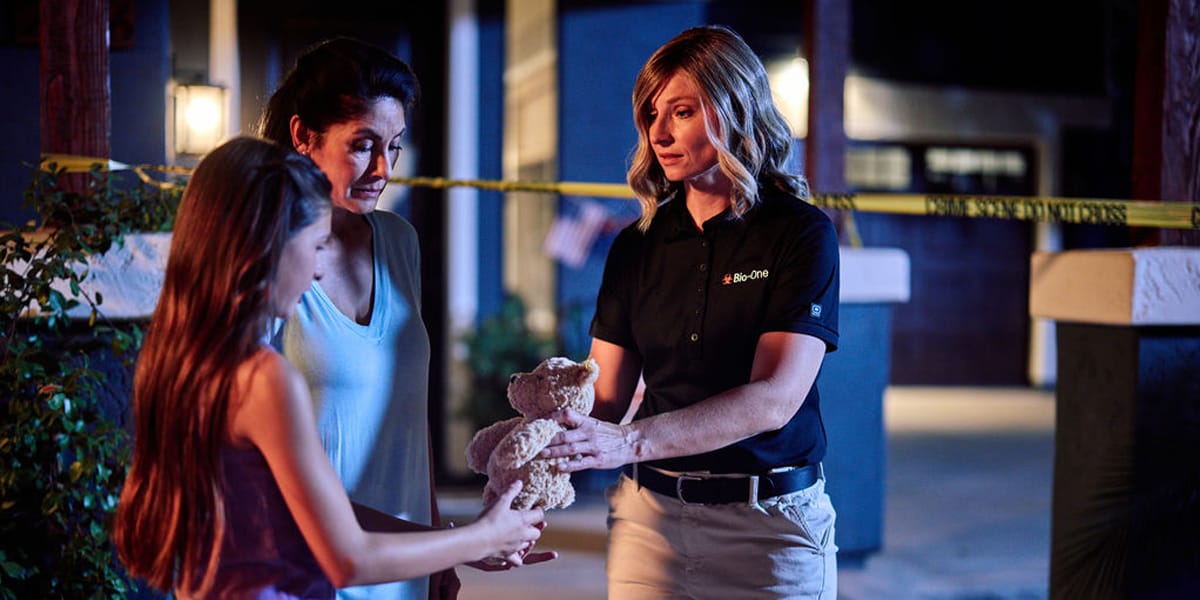
Every Bio-One location is locally owned and operated by people who live in the same community they serve. When you call, you won’t get a call center or a voicemail tree — you’ll speak to someone right here who understands what you’re going through and can help right away.
Our certified professionals are trained to handle all kinds of biohazard situations, including trauma scenes, hoarding, and unattended deaths. But what really sets us apart is how we handle them: with empathy, discretion, and respect.
We know that opening your home or business to a cleanup crew takes trust. That’s why we arrive quietly, explain clearly, and stay until every detail is handled — not just to industry standards, but to human ones.
It’s easy to say “we care.” We prefer to show it. Here’s what you can always expect when you call:
No matter what you’re facing, you don’t have to face it alone. Bio-One is ready when you are — with empathy, expertise, and immediate help when it matters most.
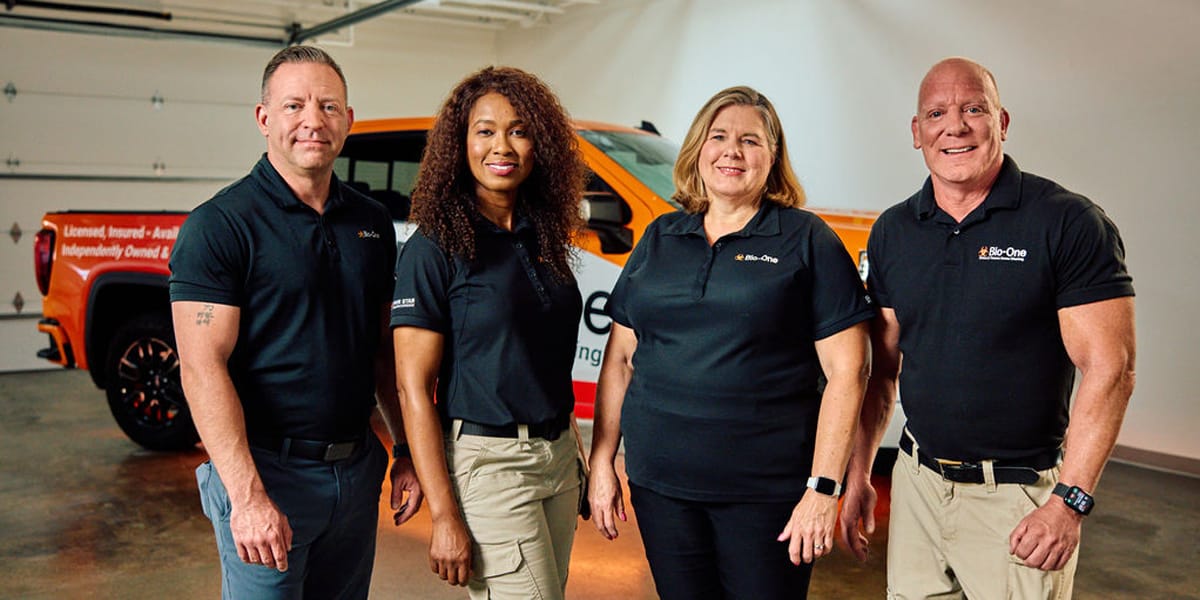
When you’re dealing with a sensitive or complex cleanup, the difference between “cleaned up” and “professionally cleaned” comes down to who you call.
Bio-One has earned the trust of law enforcement, property managers, and families across the country because we go deeper — literally and figuratively. Our work extends beyond what you can see to ensure every affected area is safe and habitable again.
Here’s what sets us apart:
We know picking up the phone can feel overwhelming. That’s why we make what happens next as simple and supportive as possible.
It’s more than a process. It’s peace of mind.
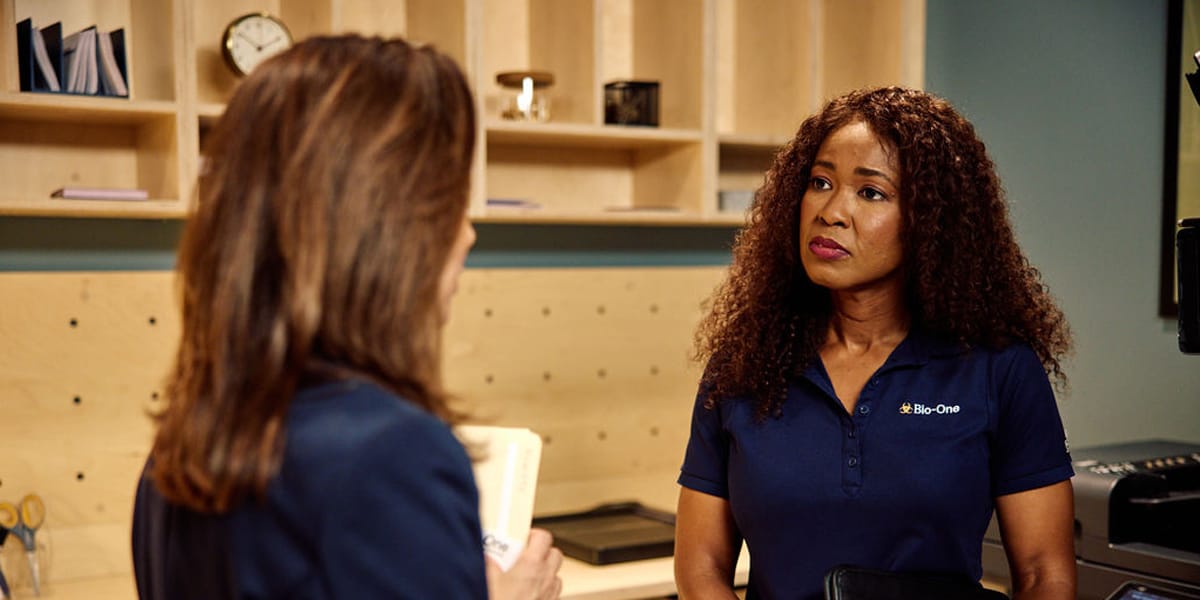
At the heart of everything we do is one guiding principle: Help First, Business Second.
That means showing up when someone calls at 2 a.m., answering every question with patience, and treating every space with dignity. It means remembering that behind every call is a person who needs understanding as much as cleanup.
Our promise to you is simple:
That’s what it means to Help First. Business Second.
When life takes an unexpected turn, the right help makes all the difference.
Whether it’s a biohazard, trauma, hoarding, or other challenging cleanup, Bio-One of Chicago is here — real people, real help, available 24/7. From your first call to the final walkthrough, we guide you through every step with compassion, care, and professionalism.
Because in moments that feel impossible, you deserve more than a cleanup.
You deserve a team that helps you move forward.
Call now for immediate help:
Available 24/7 — nights, weekends, and holidays.
What makes Bio-One different from other cleanup companies?
Bio-One leads with compassion, not just cleanup. Our “Help First, Business Second” philosophy, certified training, and rapid response set us apart in a crowded field.
What types of cleanup services do you provide?
We handle a wide range of situations, including crime scene cleanup, trauma and death cleanup, hoarding remediation, and other biohazardous environments.
Are your technicians certified?
Yes. Every Bio-One technician is professionally trained, licensed, and certified in OSHA safety standards, bloodborne pathogen handling, and industry best practices.
How quickly can you respond to a call?
We pride ourselves on fast response times. Most calls receive a same-day response, often within just a few hours.
Is Bio-One available 24/7?
Absolutely. You can reach us any time — day or night, weekends, or holidays — and you’ll always speak with a real person who’s ready to help.
Do you work with insurance providers?
Yes. We can coordinate directly with your insurance company to streamline the claims process and reduce stress for property owners.
How do you handle client privacy?
Discretion is a top priority. We respect your privacy and can arrive in unmarked vehicles upon request. All client details are kept entirely confidential.
What can I expect when I contact Bio-One?
You’ll reach a compassionate, trained specialist who listens, explains your options, and guides you through every step — from initial call to final cleanup.
What safety protocols do you follow?
Every Bio-One cleanup follows strict OSHA, EPA, and IICRC standards for containment, disinfection, and disposal of biohazardous materials.
How many people has Bio-One helped?
Bio-One has helped thousands of families, property managers, and first responders nationwide — each one receiving the same care, respect, and professionalism that define who we are.
When tragedy strikes, families are left carrying a weight that goes far beyond the incident itself. A crime scene isn’t just about what happened—it’s about what’s left behind. For families, returning to that space can be overwhelming. It’s a reminder of loss, fear, and pain at the very moment when what they need most is comfort and support.
Yet in the middle of grief, families quickly learn something few expect: the responsibility for cleanup doesn’t fall to the police, the city, or investigators. It falls to them.
That realization can be crushing. The good news is, no one has to face this burden alone. Professional crime scene cleanup isn’t just about restoring a property—it’s about helping families take the first step toward healing.
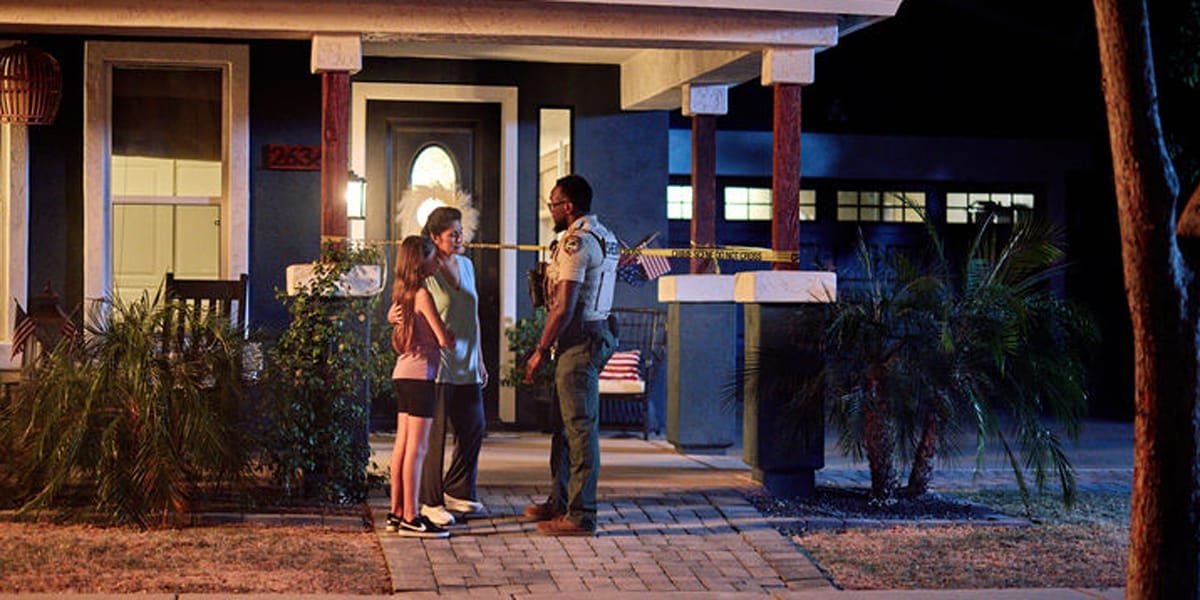
____________________________
When the unthinkable happens, the last thing families should have to worry about is how to clean up the aftermath.
____________________________
Every family’s experience is unique, but the emotional impact of encountering a crime scene often follows the same painful threads:
For many families, the hardest part is the sense of being alone in this process. They didn’t choose to be in this situation, and yet the responsibility for restoring their home now rests on their shoulders.
____________________________
Did You Know?
Research has shown that when people are repeatedly exposed to trauma reminders in their living environment, symptoms of grief and post-traumatic stress disorder (PTSD) can last longer and become more severe.
____________________________
Who Handles Crime Scene Cleanup?
After investigators finish their work, who is responsible for cleaning a crime scene?
Answer: C Most families are surprised—and overwhelmed—to learn that the responsibility for cleanup falls on them.
____________________________
It might be tempting to think of crime scene cleanup as just another form of “deep cleaning.” But the truth is, it’s far more than that.
A crime scene carries both emotional weight and physical danger. Stains or remnants aren’t just unpleasant—they are vivid reminders of trauma. Even after hours of scrubbing, families may feel their space has been permanently changed.
Without proper remediation, emotional healing can stall. Families deserve to reclaim their homes without being constantly reminded of what happened there.
Imagine walking into your living room after a traumatic event. The carpets look clean, but you notice faint stains or an odor that lingers. Do you feel comforted—or do you feel the weight of what happened, all over again?
This is why professional restoration matters. It’s not just about appearance—it’s about peace of mind.
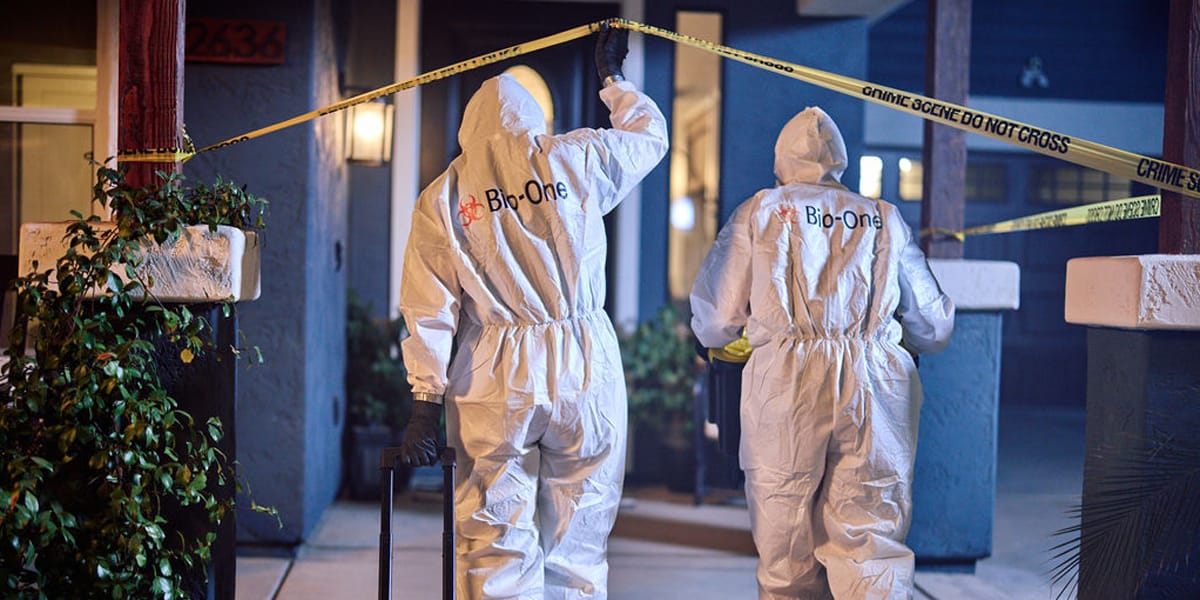
While the emotional toll of a crime scene is often the most visible, there are also unseen dangers that linger long after the incident. These risks don’t always appear on the surface, which can create a false sense of security if cleanup is attempted without professional assistance.
Blood and bodily fluids may appear as stains, but they can pose serious health risks. Viruses such as HIV, Hepatitis B, and MRSA are known to survive outside the body for hours, days, or even longer, depending on the conditions.
Exposure isn’t limited to direct contact—microscopic droplets or residue on surfaces can also spread disease if touched or aerosolized during cleaning. Without the proper protective equipment and disinfectants, anyone attempting to clean the scene risks infection.
What families often don’t realize is how quickly fluids can seep into porous materials like wood, carpet, drywall, or subflooring. Even when a surface looks clean, contaminants may have traveled deeper, where bacteria thrive unseen. Over time, this can lead to:
In some cases, entire sections of flooring, furniture, or drywall must be removed and replaced to ensure the home is truly safe.
Odors are more than an inconvenience—they are a sign that microscopic contaminants are still present. The smell of blood, decomposition, or other biohazards can cling to fabrics, penetrate HVAC systems, and reappear long after the space seems “clean.”
These odors not only retraumatize families but also signal ongoing health risks if the underlying contamination has not been entirely removed.
Standard household cleaners and DIY efforts are insufficient to eliminate these dangers. Specialized tools—such as ozone machines, ATP testing (to verify sanitation), and EPA-registered disinfectants—are required to restore the environment safely.
Professional remediation doesn’t just clean what’s visible; it addresses the hidden layers of contamination to ensure the home is safe, stable, and livable once again.
____________________________
Did You Know?
Biohazard materials can penetrate surfaces like wood and drywall within minutes. Even if a surface appears clean, harmful bacteria may remain hidden, posing ongoing health risks and potentially causing costly property damage if left untreated.
____________________________
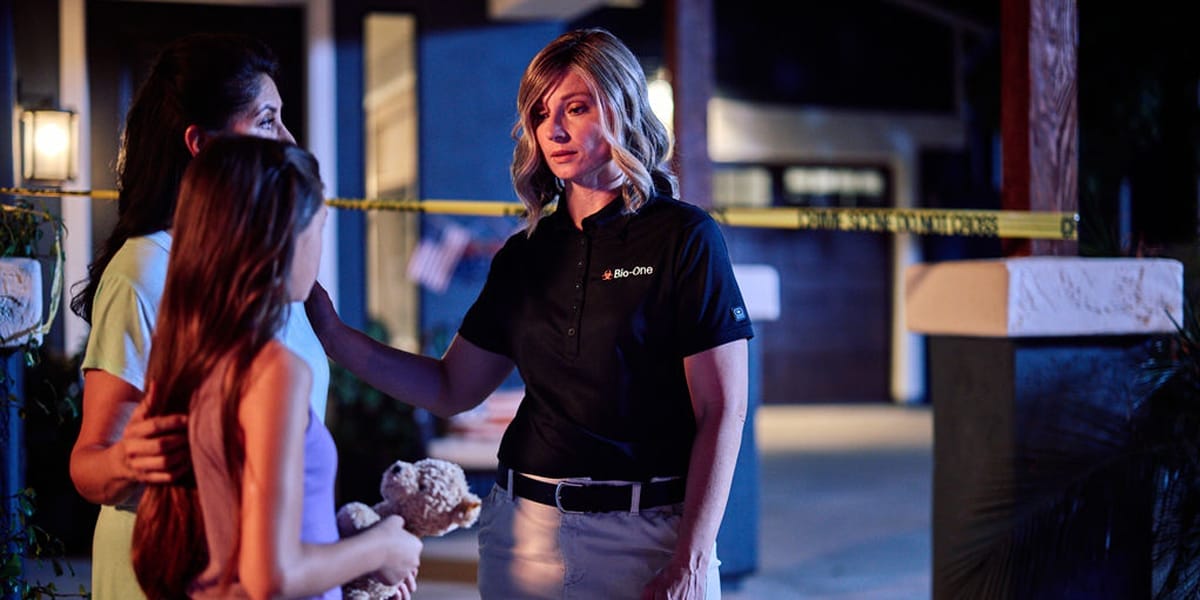
When tragedy strikes, cleanup is never just about sanitizing a space—it’s about helping families start the recovery process. Professional crime scene cleanup goes beyond surface-level cleaning to restore health, safety, and dignity.
Professionals don’t just wipe down visible surfaces. They utilize advanced remediation techniques, including ATP testing to confirm sanitation, medical-grade disinfectants, and specialized equipment that penetrates deep into porous materials where contaminants may hide.
Odor neutralization systems, air filtration, and biohazard disposal protocols ensure the space is genuinely safe and habitable again.
This level of restoration allows families to step back into their homes without fear or hesitation. Instead of seeing reminders of what happened, they see a clean, stable environment where healing can begin.
A crime scene isn’t just physically hazardous—it’s also deeply personal. The presence of marked vans, large crews, or public attention can add unnecessary shame or stress to an already painful time.
That’s why professional cleanup companies prioritize discretion. From arriving in unmarked vehicles to working quietly behind closed doors, their goal is to protect the family’s privacy and dignity at every step.
Neighbors don’t need to know, and families don’t need to feel exposed.
This respectful approach creates space for loved ones to grieve without added pressure or embarrassment.
Technical training matters, but so does the human element. The best cleanup professionals understand they are stepping into a family’s darkest hour. Every word, every action, is guided by empathy as much as expertise.
That compassion shows up in small but meaningful ways:
For many families, this combination of professional skill and personal compassion makes all the difference. Cleanup isn’t just about removing hazards—it’s about helping people take the very first step toward healing.
____________________________
When Families Should Call a Professional
If any of these apply, professional help is the safest path forward.
____________________________
While emotional support and compassion are at the heart of professional cleanup, the practical relief it brings to families can’t be overstated.
In moments of crisis, even simple logistics can feel overwhelming. By stepping in, professionals assume the responsibility that families should never have to bear alone.
At the top of the list is protection from hidden hazards. Professional cleanup ensures that all bloodborne pathogens, bodily fluids, and contaminated materials are entirely removed—not just from visible surfaces, but from flooring, walls, and air systems.
This prevents the spread of illness, mold, and bacteria that can threaten residents long after the initial incident. Families gain peace of mind knowing their home is not only clean, but safe to live in again.
Navigating insurance paperwork is the last thing grieving families want to deal with, yet it’s often a necessary step in covering cleanup costs. Professional companies like Bio-One routinely help with this process. They provide detailed documentation, photos, and reports required for claims and even communicate directly with adjusters when needed.
This kind of support can reduce financial stress and eliminate the confusion of trying to figure out coverage alone—saving families both time and worry.
Perhaps the most valuable gift of all is freedom from the burden of having to do it themselves. Without professional help, families might feel pressure to handle cleanup personally or to assign the task to friends, property staff, or maintenance crews.
Not only is that unsafe, but it also adds another layer of emotional strain to an already devastating situation.
Professional cleanup teams lift that weight off families’ shoulders. They manage the logistics, disposal, labor, and details—so families can focus entirely on what truly matters: grieving, remembering, and beginning to heal.
____________________________
Did You Know?
Many homeowners’ insurance policies cover crime scene cleanup. Families often don’t realize this, and it can significantly reduce the financial burden.
____________________________
For families, cleanup is often the first real step toward moving forward. It takes the space of trauma and restores it into a place where life can begin again.
It doesn’t erase what happened, but it creates the foundation for healing—without the constant physical reminders that might otherwise prolong the pain.
At Bio-One, our mission has always been Help First, Business Second. That means putting people and healing at the center of every service we provide.
____________________________
Pause & Reflect:
If someone you loved went through a tragedy, how would it feel to know that professionals could quietly remove the burden of cleanup—so you could focus on what matters most?
____________________________
A crime scene leaves more than physical damage—it leaves emotional wounds that take time to heal. Professional cleanup is not just about restoring a property; it’s about easing the weight families carry and creating space for recovery.
If you or someone you know is faced with the unimaginable, remember: you don’t have to handle it alone. Bio-One of Chicago is here to provide compassionate, professional help when it matters most.
October is recognized nationwide as National Crime Prevention Month, a time when communities, law enforcement, and organizations come together to raise awareness and share strategies for reducing crime.
While no one can prepare for every situation, taking small, consistent steps can make homes and neighborhoods safer.
Here are a few ways families and communities can take part:
Personal Awareness
By combining awareness, preparedness, and community support, we can all play a part in preventing crime and creating safer places to live, work, and heal.
Cleanup is not handled by law enforcement or the city. It falls to the property owner or family, which is why professional help is often essential.
Crime scenes can contain hidden dangers like bloodborne pathogens, structural damage, and lingering odors. Without proper equipment and training, cleanup can compromise health, safety, and emotional well-being.
Blood and bodily fluids can carry viruses such as HIV, Hepatitis B, and MRSA. Even when stains aren’t visible, harmful bacteria may remain in flooring, walls, or fabrics.
Restoring the home to a safe, clean condition removes painful reminders of trauma. It creates a supportive environment where families can grieve, remember, and eventually move forward.
Professional cleanup companies, like Bio-One, often arrive in unmarked vehicles and work quietly to protect your privacy and dignity.
In many cases, yes. Homeowners’ insurance often covers the cost of professional biohazard cleanup. Cleanup companies can help with documentation and communication with adjusters.
Ordinary household cleaners can’t fully remove biohazards. Professionals utilize advanced tools, including ATP testing, medical-grade disinfectants, and odor neutralization systems, to ensure the environment is completely safe.
Depending on the virus and conditions, pathogens can survive for hours, days, or longer. That’s why professional remediation is critical, even if a surface looks clean.
Keep people and pets out of the area, avoid touching or attempting to clean, and call a certified crime scene cleanup professional as soon as possible.
National organizations like NOVA (https://trynova.org), OVC (https://ovc.ojp.gov ), and VictimConnect (https://victimconnect.org) offer advocacy, resources, and confidential support services.
Police cruisers, transport vans, K9 units—law enforcement vehicles aren’t just cars. They’re mobile workstations, holding cells, and lifelines for the officers inside. Every shift brings new and unpredictable challenges, and with those challenges come unseen risks.
From transporting injured individuals to responding to drug-related incidents, squad cars often carry more than their occupants. They carry invisible hazards that don’t disappear when the call is over.
Without professional decontamination, those vehicles can become a dangerous environment for officers, detainees, and anyone else who enters.

Every day, law enforcement vehicles are exposed to situations that most people never imagine. While they might look clean from the outside, the reality is that these vehicles often carry invisible hazards that ordinary cleaning can’t erase. These dangers are far from everyday dirt or dust—they’re biohazards with the potential to harm anyone who steps inside.
Blood, vomit, urine, and other fluids often end up in the back seat or on floor mats after incidents involving injuries, illness, or altercations. These fluids aren’t just unpleasant—they can carry dangerous pathogens like HIV, Hepatitis B and C, and MRSA.
Once absorbed into porous materials, such as upholstery or seatbelts, they can linger undetected, putting officers and detainees at risk long after the original incident.
Encounters with narcotics bring another serious threat. Even microscopic traces of substances like fentanyl, heroin, or methamphetamine can remain on surfaces. These residues are invisible to the naked eye, but they can cause severe health effects if inhaled, touched, or transferred onto other objects.
Officers reaching for a seatbelt or resting an arm on a door panel could unknowingly expose themselves to life-threatening toxins.
When detainees or passengers carry contagious illnesses—whether the seasonal flu, tuberculosis, or COVID-19—those pathogens don’t disappear when they leave the vehicle.
Viruses and bacteria can settle on frequently touched surfaces such as door handles, seatbacks, or partitions, and can also circulate through HVAC systems.
Without proper decontamination, officers may breathe in these invisible threats every time the air conditioning or heater is turned on.
One of the most dangerous surprises in law enforcement vehicles comes from what’s left behind. Used needles, razor blades, or contaminated personal belongings can be hidden under seats, stuffed into seat crevices, or tucked inside door pockets.
These items pose a high risk of accidental cuts or punctures that can transmit bloodborne pathogens. Even routine maintenance or vehicle cleaning can become hazardous if sharps are overlooked.
These threats extend far beyond the vehicle itself. They don’t just endanger the officer behind the wheel—they also put detainees, mechanics, custodial staff, and even family members at risk if contaminants are carried home on clothing or gear.
Without specialized biohazard decontamination, a squad car can quickly turn from a tool of protection into a source of harm.

At first glance, wiping down hard surfaces, spraying disinfectant, or running a vacuum should be enough to keep a squad car clean. However, when it comes to biohazards, appearance can be deceiving.
Law enforcement vehicles aren’t just dirty—they’re contaminated. And contamination requires much more than a surface-level wipe. Here’s why DIY or in-house cleaning often leaves critical risks behind:
Most pathogens and drug residues can’t be seen with the naked eye. A seat may look spotless but still harbor microscopic traces of Hepatitis, MRSA, or fentanyl dust. Standard cleaners may remove visible stains, but they aren’t designed to neutralize high-risk biohazards at a molecular level.
This means vehicles can appear “clean” while still posing serious health risks every time someone steps inside.
Squad cars are full of porous surfaces—seatbelts, upholstery, fabric flooring, even foam padding—that readily absorb bodily fluids and bacteria. Once contaminants seep in, they don’t simply wipe away.
Household cleaners can’t penetrate deep into these materials, leaving behind hidden reservoirs of pathogens that may linger for weeks or months. Over time, even a small spill can spread contamination throughout the vehicle.
Even if fluids or sharps are removed, what happens next matters. Tossing blood-soaked rags, contaminated gloves, or used needles into regular trash creates serious risks for custodial staff, mechanics, and sanitation workers.
Without certified biohazard disposal protocols, one person’s “cleanup” becomes another person’s dangerous exposure. Mishandling of this waste can also result in costly regulatory violations.
Officers or maintenance staff attempting DIY cleaning rarely have access to proper personal protective equipment (PPE). Without respirators, puncture-resistant gloves, or hazmat suits, they are left vulnerable to skin contact, needle sticks, or inhalation of airborne particles. The attempt to clean may actually increase exposure for the person doing the work.
Vehicle interiors are compact, layered, and complex. Fluids seep between seat crevices, drug powder drifts into vents, and pathogens circulate through HVAC systems. A spray bottle and rag simply can’t reach these hidden zones.
Without specialized equipment and techniques, these areas remain untreated, allowing contaminants to spread each time the vehicle is used.
The bottom line: what looks clean may still be hazardous. Standard cleaning methods can make surfaces look presentable, but they can’t guarantee that invisible, high-risk contaminants are gone. Only professional biohazard remediation ensures that every inch of the vehicle—from visible surfaces to hidden crevices—is truly safe for officers, detainees, and the community.
| DIY / In-House Cleaning | Bio-One Professional Decontamination |
| Uses household or automotive cleaners not designed for biohazards. | Uses medical-grade disinfectants that neutralize pathogens and drug residues at a molecular level. |
| Focuses on visible dirt and stains. | Targets both visible and invisible contaminants, including bloodborne pathogens and fentanyl dust. |
| Limited reach—seat crevices, HVAC systems, and porous materials often remain contaminated. | Specialized equipment cleans deep into upholstery, vents, and hidden spaces. |
| No certified biohazard disposal—waste is often discarded improperly, creating new risks. | OSHA-compliant disposal of sharps, fluids, and contaminated materials prevents secondary exposure. |
| Performed by untrained staff without proper PPE, increasing exposure risk. | Trained technicians with full protective gear handle every step safely and discreetly. |
| Vehicles may appear clean but remain hazardous. | Vehicles are restored to a safe, sanitary state—ready for service without hidden dangers. |

Every law enforcement vehicle tells a story—one of fast responses, high-pressure calls, and unpredictable encounters. With so much at stake, “clean” isn’t good enough. Vehicles must be safe. That’s where Bio-One steps in.
Our vehicle decontamination service is specifically designed to address the unique risks faced by law enforcement officers. We don’t just wipe surfaces or mask odors—we restore vehicles to a truly safe state, using proven biohazard remediation protocols designed for high-risk environments.
Here’s what professional decontamination with Bio-One looks like:
We use hospital-grade disinfectants formulated to neutralize viruses, bacteria, and drug residues at the molecular level. These cleaners eliminate pathogens like Hepatitis, HIV, or MRSA, and render narcotics like fentanyl and methamphetamine harmless—far beyond the capabilities of over-the-counter products.
Contaminants don’t always stay where they’re visible. Fluids seep into seat crevices, powder drifts into HVAC vents, and pathogens cling to hard-to-reach corners. Our technicians utilize professional-grade tools and technology to target and sanitize these areas, ensuring that no hidden hazards remain.
Removing contaminants is only half the job. The other half is disposing of them safely. Our team follows strict OSHA and EPA guidelines to handle and transport biohazardous waste—whether it’s sharps, blood-soaked materials, or contaminated items—ensuring that nothing poses a risk to custodial staff, waste handlers, or the community.
Unpleasant odors often indicate more severe contamination. Instead of masking smells with air fresheners, we trace odors to their origin—whether it’s fluids trapped in upholstery or residue in ventilation systems—and remove the hazard completely. The result: vehicles that smell clean because they are, in fact, clean.
We know every squad car is essential to department readiness. That’s why our processes are both thorough and efficient. Vehicles are decontaminated quickly without cutting corners, allowing them to return to service safely, often within hours.
When Bio-One decontaminates a law enforcement vehicle, officers can trust they’re stepping into a safe environment, detainees are transported without unnecessary risk, and communities know their departments are protecting not only public safety but also the health of those who serve.

Skipping or delaying proper vehicle decontamination isn’t just about appearances—it carries serious consequences that ripple across the department. What may seem like a minor oversight can quickly turn into a health emergency, a lawsuit, or a disruption in daily operations.
Every ride in a contaminated vehicle puts officers, detainees, and even support staff at risk. Pathogens like HIV, Hepatitis B, or MRSA can survive on surfaces for days or even weeks. A forgotten trace of fentanyl dust can be inhaled or absorbed through the skin, leading to accidental overdose. Even something as simple as adjusting a seatbelt could expose an officer to dangerous bacteria if bodily fluids have seeped into the fibers. Over time, repeated exposure can take a toll on an officer's health, leading to sick leave, long-term illness, or worse.
If a detainee contracts an illness or an officer experiences accidental exposure because of an improperly cleaned squad car, the department could face serious legal consequences.
Lawsuits alleging negligence, unsafe working conditions, or failure to follow biohazard protocols can not only result in financial settlements but also damage community trust. Workers’ compensation claims from exposed officers and regulatory fines for improper disposal practices can further strain budgets and reputations.
When vehicles are pulled from service unexpectedly due to contamination, departments lose vital resources. Fewer vehicles on the road mean longer response times and increased strain on the remaining fleet.
What could have been a fast, scheduled professional decontamination turns into extended downtime, costly repairs, or even replacement of contaminated vehicle components. In high-demand environments, even a single cruiser out of service can disrupt patrol schedules, emergency responses, and community coverage.
The bottom line: ignoring vehicle biohazards isn’t just risky—it’s costly, both in human terms and operational efficiency.
By investing in professional decontamination:
Professional cleanup isn’t a luxury—it’s a necessity that allows officers to do their jobs with confidence, knowing the space they work in every day is safe.
When officers call us, it’s because the stakes are high. A contaminated vehicle isn’t just an inconvenience—it’s a health risk, a liability, and a barrier to doing the job safely. That’s why departments across the country rely on Bio-One of Chicago. We bring not only technical expertise but also an understanding of the sensitivity and urgency behind every call.
Our crews aren’t general cleaners—they’re certified biohazard remediation professionals. Every technician is trained in bloodborne pathogen handling, trauma cleanup, and the safe decontamination of drug residues like fentanyl and methamphetamine. This training ensures that when we step into a squad car, we know exactly how to neutralize risks and restore safety without guesswork.
We recognize that law enforcement work is already in the public eye. That’s why our teams operate with total discretion. We arrive in unmarked vehicles, use plain uniforms, and work quietly so cleanup doesn’t draw unwanted attention. For officers, detainees, and the community, that privacy matters—it keeps sensitive situations from becoming public issues.
Emergencies don’t wait, and neither do we. Bio-One of Chicago is available 24/7 with local teams ready to respond at a moment’s notice. Whether it’s a single contaminated cruiser after an altercation or multiple vehicles needing decontamination following a large event, we’re equipped to handle the job quickly. The faster we respond, the sooner vehicles are back in service, protecting the community.
No two departments—or incidents—are the same. Some need a one-time deep decontamination after a high-risk encounter, while others benefit from scheduled fleet maintenance to keep vehicles consistently safe. Bio-One collaborates with each department to develop solutions tailored to their operational needs and budgets. Our flexibility ensures agencies always get the right level of support.
Behind every cleanup is a human story. Whether it’s an injured detainee, an officer exposed to risk, or a family impacted by tragedy, we never lose sight of the people involved. Our technicians approach every vehicle with care, respect, and empathy, because restoring safety isn’t just about sanitizing surfaces—it’s about protecting the lives and dignity of those who rely on these vehicles every day.
For law enforcement, trust is everything. Bio-One has earned that trust by showing up fast, working with precision, and honoring the responsibility that comes with cleaning the spaces officers depend on. When the call comes, agencies know they’re not just getting cleaners—they’re getting a partner dedicated to keeping their teams, detainees, and communities safe.
First Responders Month is a powerful reminder of the risks law enforcement officers face every single day. While they work to protect our communities, Bio-One of Chicago is here to protect them—ensuring the vehicles they depend on remain safe, sanitized, and ready for service.
Because when the shift ends, every officer deserves to go home healthy. And every detainee, technician, and passenger deserves a vehicle free of hidden hazards.
When safety is at stake, don’t leave it to chance. Bio-One offers professional squad car decontamination, keeping your fleet ready and your personnel protected.
Protect your officers. Protect your fleet. Protect your community.
Because squad cars aren’t just dirty—they’re contaminated. Biohazards like blood, vomit, fentanyl residue, or airborne pathogens require medical-grade cleaning agents and specialized equipment that standard cleaning products can’t match.
Common risks include bodily fluids (blood, vomit, urine), microscopic drug residues (such as fentanyl or methamphetamine), airborne pathogens (like influenza, TB, or COVID-19), and sharps or hidden items left behind after transport.
Some viruses and bacteria can live on surfaces for days or weeks. Drug particles like fentanyl remain dangerous indefinitely until they are professionally neutralized.
DIY cleaning removes surface dirt, but contaminants absorbed into upholstery, seatbelts, or HVAC systems remain untreated. Vehicles can appear clean while still harboring invisible hazards.
Officers risk accidental overdose from fentanyl exposure, infections from bloodborne pathogens, or respiratory illness from airborne viruses. Repeated exposure can lead to long-term health issues and missed work.
Yes. Detainees, technicians, custodial staff, and even officers’ family members can be exposed if hazards are carried on clothing, equipment, or skin.
Bio-One follows OSHA and EPA guidelines for certified handling and disposal. Sharps, contaminated fabrics, and waste are collected, packaged, and disposed of through approved biohazard channels—keeping staff and the public safe.
Most decontaminations are completed within hours. Our goal is to minimize downtime while ensuring that vehicles are thoroughly safe before returning to the road.
Absolutely. We offer one-time cleanings for urgent needs as well as scheduled fleet maintenance programs that keep vehicles consistently safe and compliant.
Bio-One technicians are certified biohazard specialists, not general cleaners. We arrive discreetly in unmarked vehicles, respond 24/7, and bring both compassion and technical expertise. Our focus is on restoring vehicles to a safe state while protecting the officers and communities who rely on them.
As a property manager, you’re the go-to for just about everything. Leaky faucet? You’ve got someone for that. Broken light fixture? You’re already on it. When a tenant moves out and leaves a mess behind, your maintenance crew knows the drill: clean, repair, and reset.
Situations involving blood, bodily fluids, drug residue, or extreme hoarding go far beyond the scope of general maintenance. They’re biohazard scenes, and treating them like any other mess can create serious consequences for your team, your tenants, and your property.
This isn’t just about cleaning up. It’s about protecting people’s health, following safety regulations, and preventing long-term damage to your investment.
You wouldn’t ask your handyman to handle electrical rewiring without proper training. So why risk their safety—and your liability—by asking them to clean up a potentially infectious scene?

Crime scenes. Unattended deaths. Hoarding situations. Drug residue. Sewage backups.
These aren’t just unpleasant—they’re hazardous, legally complex, and emotionally heavy.
Yet many property managers still default to their maintenance crew or janitorial team when these events happen, assuming it’s “just another mess to clean.”
But this isn’t a clogged sink or scuffed floor. It’s a potential public health risk, and it requires far more than elbow grease and cleaning supplies.
In these moments, well-meaning isn’t enough. Without the proper training and equipment, even a simple wipe-down can become a dangerous—and expensive—mistake.
Proper biohazard remediation demands:
Biohazard scenes may contain HIV, hepatitis B/C, or drug contaminants like fentanyl. One misstep can expose your crew—and your tenants—to serious health risks.
Gloves and masks aren’t enough. Professional teams use PPE (personal protective equipment), containment barriers, and HEPA-filtered vacuums to stop the spread of contaminants during and after cleanup.
Blood-soaked materials, sharps, and hazardous waste must be handled and transported according to strict regulations. Most general cleaning crews aren’t trained in these requirements, putting you at risk of non-compliance and fines.
Biohazard scenes often follow traumatic events. Cleaning up after an unattended death or suicide takes more than a strong stomach—it requires sensitivity, discretion, and the ability to work calmly in highly emotional environments.
Expecting your regular crew to take this on isn’t just unfair—it’s unsafe. The bottom line: if they haven’t been trained for it, they shouldn’t be doing it. Period.
On paper, handling a cleanup in-house is a budget-friendly move. You’ve already got a crew. Why not just hand them some gloves and cleaning supplies and knock it out?
But when the mess involves biohazards, drug residue, or extreme filth, doing your best without professional training is a gamble—and one that rarely pays off.
Here’s what that decision can really cost you:
Surface-level cleaning may not eliminate deep contamination. If a unit still smells, shows stains, or makes tenants uncomfortable, you’ll struggle to lease it, losing days, weeks, even months of income.
Blood, decomposition, urine, and mold leave behind odors that typical cleaning solutions can’t touch. Tenants may report “a weird smell,” but the real issue is invisible contamination that continues to spread.
Biohazards soak into subfloors, drywall, HVAC systems, and insulation. Without professional remediation, you risk locking those problems in, forcing costly repairs down the road.
If a future tenant gets sick or discovers the prior condition, you could face lawsuits, health department fines, or a damaged reputation. Many biohazard scenarios require strict adherence to OSHA and EPA regulations—cutting corners opens you to major consequences.
Your maintenance crew didn’t sign up to deal with hazardous waste. If they’re injured or infected while cleaning, you could be held responsible for their medical costs and lost wages.
What starts as a “small mess” can quickly snowball into a major issue, costing you more time, more money, and more stress than hiring professionals would have from the start.

When your property is facing a situation involving blood, bodily fluids, drug residue, hoarding, or sewage, it’s not just dirty—it’s dangerous and deeply complex. This is where your standard cleaning crew reaches its limit—and where Bio-One steps in.
We’re not a janitorial service. We’re a professional biohazard remediation team trained to handle the scenes no one else should touch.
Here’s what sets Bio-One apart:
Every Bio-One technician is certified in handling bloodborne pathogens, trauma scenes, and chemical decontamination. From fentanyl residue to decomposition fluids, we know how to clean safely, thoroughly, and in compliance with strict OSHA standards.
Biohazard events don’t wait for business hours—and neither do we. Whether it’s 2 a.m. or a holiday weekend, our team is ready to respond fast and begin remediation, minimizing disruption to your tenants and timeline.
We understand how sensitive these situations can be. Our teams arrive in unmarked vehicles and plain uniforms to protect your privacy and your property's reputation. We work quietly and professionally to avoid drawing attention to the situation.
We don’t just wipe down surfaces. Our team investigates what’s behind walls, under floors, and inside vents—because biohazards often seep into areas you can’t see. We eliminate not just the visible mess, but the root causes of odor, bacteria, and health risks.
Biohazard claims are complicated, but we make them easier. Our team handles documentation, photos, and direct communication with your insurance adjuster, saving you time, stress, and paperwork.
When it’s more than just a mess—when it’s a potential threat to health, safety, and liability—you need certified professionals who know what they’re doing and care about doing it right.
Bio-One is here to take that burden off your plate so that you can move forward with confidence.
You’ve built a reputation for running a clean, safe, and professional property. Every decision you make—from the paint color in the hallways to the landscaping out front—affects how your tenants (and future tenants) see you.
That reputation can unravel in an instant if a serious cleanup is handled the wrong way.
The truth is:
Your maintenance team isn’t trained—or equipped—to manage trauma scenes, drug contamination, or biohazard remediation.
And honestly, they shouldn’t be. That’s not their job. It’s not in their job description. And expecting them to take on that kind of risk puts everyone in a dangerous position.
Biohazard cleanup isn’t about wiping up a mess. It’s about:
Bio-One is here, so you don’t have to shoulder this burden alone.
We’re a trusted partner to property managers across the country—ready 24/7 to respond fast, work discreetly, and handle the toughest situations with care and professionalism.
Let your staff do what they do best: keep your property running smoothly.
And let Bio-One take care of the rest—quietly, quickly, and thoroughly.

Disasters don’t wait for you to be ready. A tenant passes away. A unit is discovered in a hoarding state. A sewage backup catches you off guard. When these situations arise, every hour counts—and scrambling to find the right help in the middle of a crisis can lead to costly delays, safety issues, and missteps you can’t afford.
That’s why the smartest move you can make right now is to partner with Bio-One of Chicago—before an emergency hits.
Here’s how to take the first step:
We serve our communities with care, and we show up when it matters most.
Don’t wait until you’re in the middle of a mess to start looking for help.
Be ready. Be protected. Be proactive—with Bio-One of Chicago.
Most maintenance staff aren’t trained to safely deal with bloodborne pathogens, drug residue, or hazardous materials. Without the proper PPE, disposal methods, and regulatory knowledge, even a well-intentioned cleanup can lead to health risks, liability, and long-term property damage.
Biohazards include blood, bodily fluids, drug residue (like fentanyl), sewage backups, decomposition, animal waste, and hoarding situations. If there’s a risk of infection, contamination, or toxic exposure, it’s not a job for general cleaning crews.
Improper cleanup can spread contaminants, damage building materials, create lingering odors, or lead to lawsuits and code violations. You may also be putting your team at risk of exposure to harmful pathogens or chemicals.
Yes. Biohazards often seep into subfloors, HVAC systems, and other hidden areas. Bio-One’s certified technicians are trained to inspect and remediate beyond the surface to ensure thorough decontamination.
We offer 24/7 emergency response and can typically be on-site within hours, day or night. When every minute matters, we’re ready to help fast.
No. We understand the importance of discretion. Our teams arrive in unmarked vehicles and wear plain uniforms to protect your tenants’ privacy and your property's reputation.
Often, yes. Many biohazard incidents—such as unattended deaths or trauma scenes—are covered under property or renter’s insurance. Bio-One assists with documentation and communicates directly with adjusters to streamline the claims process.
If the situation involves law enforcement (e.g., a crime scene or death), ensure the scene has been officially released. Then call us. We’ll guide you through the rest—including what to document, what to expect, and how to move forward.
We’re certified in biohazard remediation and trauma cleanup—not just surface cleaning. We follow OSHA and EPA regulations, use professional-grade PPE and equipment, and bring compassion, sensitivity, and discretion to every scene.
Absolutely. We encourage it. We offer free biohazard readiness calls to help you prepare for potential emergencies. You’ll get peace of mind, emergency contact info, and a trusted vendor already in your system.
Cleaning up after hoarding isn’t just about tossing junk into a dumpster. It’s about restoring a home—and helping someone take back their life. That’s why this job requires more than a broom and a couple of trash bags.
At Bio-One, we’ve seen firsthand what hoarding really means. We know it’s not just a mess. It’s emotional. It’s complicated. And it often hides some very real dangers.
Here’s why hiring Bio-One is the right call—and why everyday cleaning crews and junk removal services just aren’t enough.
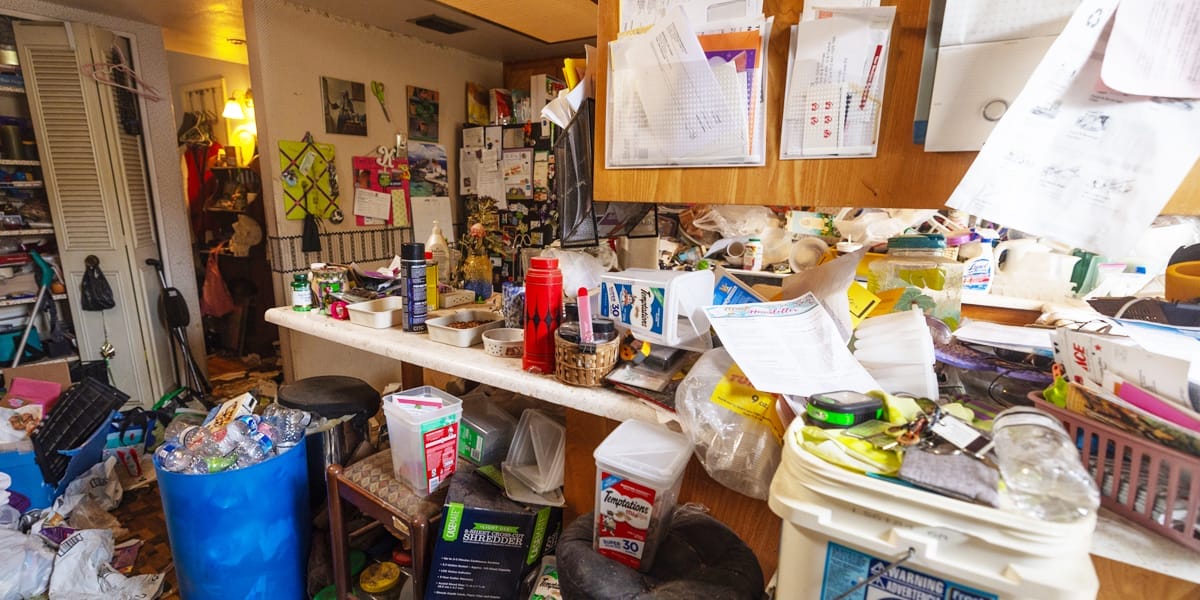
Every successful hoarding cleanup starts with one thing: a plan. But not just any plan—a personalized, compassionate roadmap designed around your unique situation.
At Bio-One, we don’t just show up with trash bags and gloves. We take the time to understand the home, the person, and the emotional weight behind it all.
Here’s how our thoughtful, professional approach sets us apart:
Trying to tackle a hoarding situation without a plan is like trying to fix a house without blueprints. A junk removal service may clear things out, but it won’t solve the deeper problems. We will.
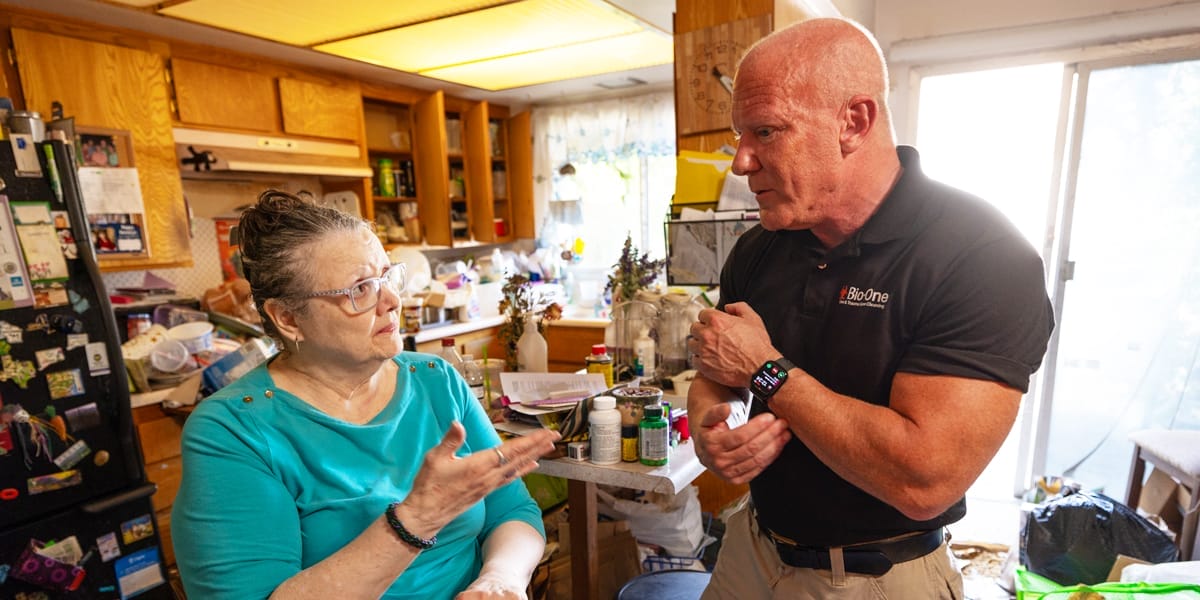
Clearing a hoarded home isn’t just time-consuming—it’s physically exhausting. What appears to be a few rooms of clutter can quickly become a grueling, multi-day challenge. This isn’t your average “spring cleaning.”
Here’s what you’re really up against:
What’s manageable in the beginning can become overwhelming fast. Even seasoned cleaning crews often underestimate the time required for hoarding cleanup and the demands it poses once the work begins.
At Bio-One, we come fully equipped with the tools, protective gear, and trained professionals to power through the most intense labor. We pace the work strategically, protect everyone’s safety, and make real progress without cutting corners.
This isn’t just about strength—it’s about stamina, strategy, and knowing how to get the job done right.
Behind the piles, underneath the clutter, and deep within hoarded homes, dangerous contaminants are often quietly festering. These aren’t just cleaning challenges—they’re serious health threats.
Most people think hoarding is just a matter of a mess. But in reality, it’s often a biohazard scene waiting to be discovered.
Here’s what might be lurking just out of sight:
All of these are considered biohazards—and they’re not something an average junk removal crew or cleaning company is trained (or legally allowed) to handle.
At Bio-One, we’re certified to clean, disinfect, and properly dispose of hazardous materials. Our teams follow OSHA standards, use full protective equipment, and know how to handle even the most extreme situations with professionalism and care.
This isn’t a job for amateurs. If biohazards are involved—and they often are—you need a team that knows what they’re doing and has the certifications to prove it.
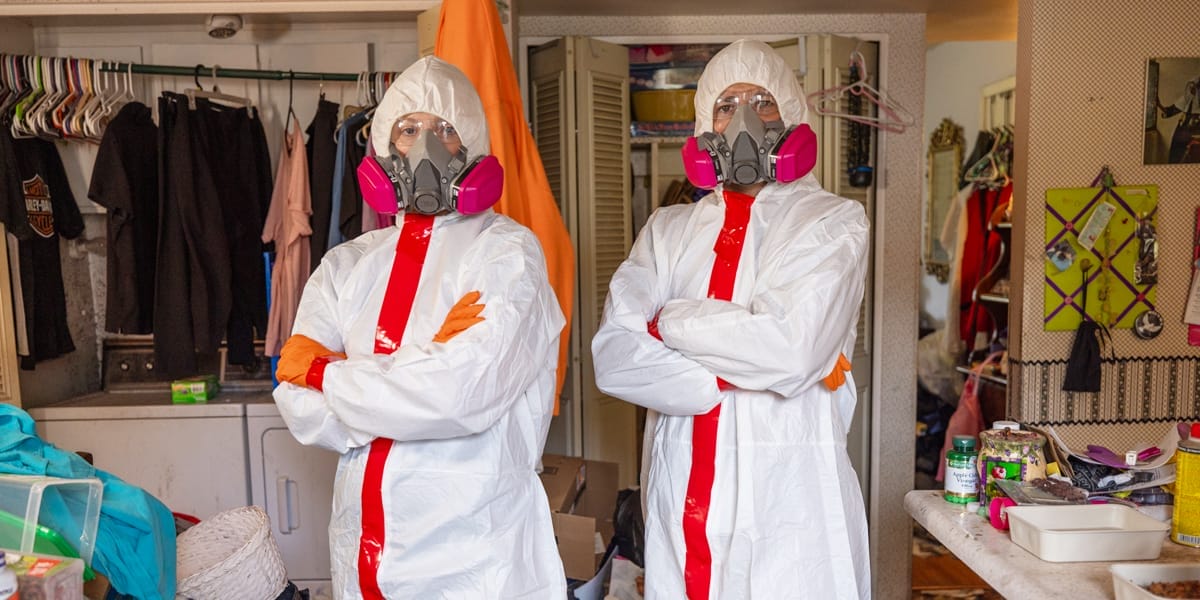
When a home becomes overwhelmed by clutter, it doesn’t just feel uncomfortable—it becomes the perfect environment for pests and rodents to move in and multiply.
All it takes is a little food waste, some moisture, and a few dark hiding places—and suddenly you’re dealing with an infestation that’s hidden in the walls, under furniture, and deep within the piles.
Here’s what’s commonly found in hoarded environments:
These pests don’t just damage property—they carry diseases like salmonella, leptospirosis, and hantavirus. Their waste can become airborne, and their presence can quickly spiral into a full-blown health crisis.
The truth? Pest problems in hoarded homes are rarely just a matter of extermination. Once pests have contaminated the environment, specialized cleaning is required to safely remove all traces and restore the space to a livable condition.
At Bio-One, we don’t just deal with the aftermath—we know how to spot the signs of infestation early, contain the spread, and safely remove biohazards left behind. We work discreetly, using professional-grade equipment and proper safety gear, so you don’t have to risk your health or well-being.
In a hoarded home, mold is more than just a patch of discoloration—it’s a growing, hidden danger that’s often overlooked until it becomes a serious health risk.
With so much clutter packed into every corner, proper airflow is restricted. That means moisture lingers, leaks go unnoticed, and humidity builds up. And mold? It thrives in those exact conditions.
Here’s why mold is such a serious concern in hoarding situations:
Cleaning up visible mold is one thing. However, in hoarded homes, mold is rarely limited to the surface. It’s often embedded deep in the environment, and removing it safely requires proper containment, specialized PPE, and professional remediation tools.
At Bio-One, we’re trained to detect, isolate, and eliminate mold as part of our hoarding cleanup process. We know where to look, how to test, and when it’s time to bring in mold remediation protocols. We also take steps to prevent regrowth, helping restore a safe and breathable living space.
When most people think of hoarding, they picture stacks of newspapers, rooms overflowing with clutter, and hallways cluttered with items. What they don’t picture—but absolutely should—is the invisible cloud of contaminated air hovering over it all.
Poor air quality is one of the most hazardous and least understood risks associated with hoarding cleanup. Every time you move a box, lift a rug, or shift a pile, you release pollutants that have been building up for years, sometimes decades.
Here’s what gets stirred into the air during a hoarding cleanup:
Prolonged exposure to this mix can lead to headaches, respiratory infections, asthma flare-ups, dizziness, and even long-term lung damage. For people with allergies, pre-existing conditions, or weakened immune systems, it can be dangerous or even life-threatening.
That’s why Bio-One technicians wear full protective gear on every job—including biohazard suits, respirators, eye protection, and gloves. We don’t just clean—we do it safely, both for ourselves and for everyone who will re-enter the space.
We also utilize professional-grade air scrubbers, HEPA vacuums, and deodorizers to enhance the air quality as we work actively, because it’s not truly clean until it’s safe to breathe.
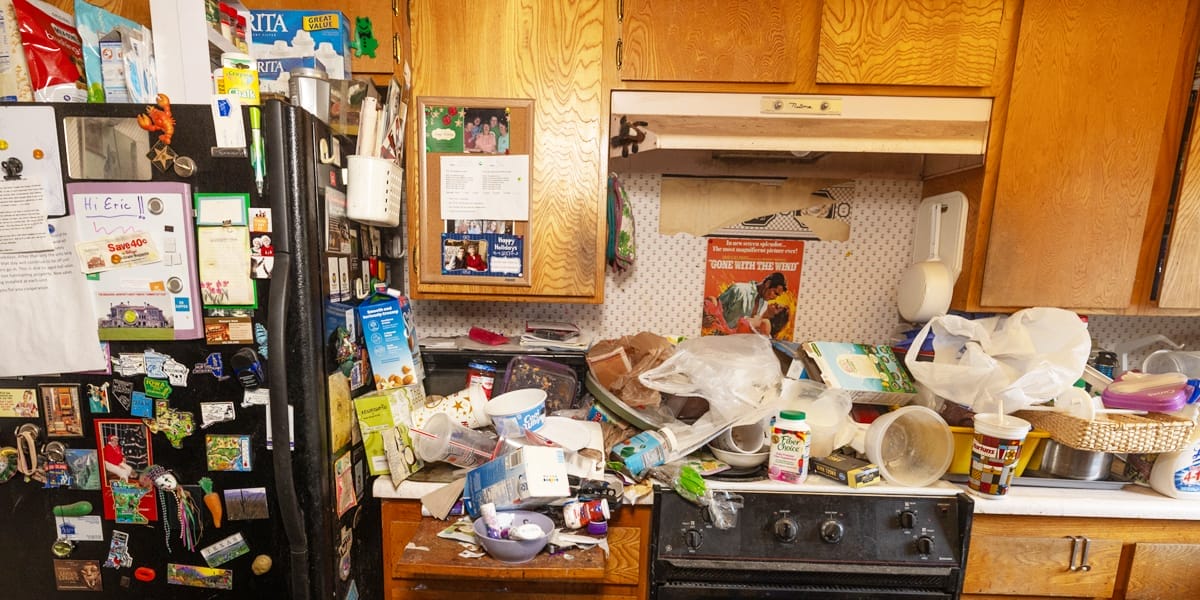
Behind every cluttered room and overstuffed hallway is a risk most people don’t consider—getting seriously injured while trying to help. Hoarding environments aren’t just hard to navigate; they’re physically dangerous, especially for anyone without the right training, equipment, or experience.
We’ve seen it happen far too often: someone with the best intentions enters a hoarded space to begin cleaning, only to walk away with a serious injury or a trip to the emergency room.
Here’s what makes these environments so hazardous:
In extreme cases, these conditions can lead to fractures, sprains, head injuries, or worse. The danger isn’t always visible, and one wrong move can lead to lasting consequences.
At Bio-One, we take safety seriously. Every cleanup is performed with full protective gear, including hard hats, puncture-resistant gloves, steel-toe boots, and back support. We use the right tools, move strategically, and always work as a team to ensure safe progress.
Your heart may be in the right place—but your body could pay the price if you go it alone. Let the professionals handle the heavy lifting—literally.
When a home is filled with clutter, the fire risks don’t just increase—they multiply exponentially. From stacks of flammable materials to blocked exits and overloaded electrical outlets, hoarded homes can become fire traps waiting for a single spark.
What makes hoarding situations so dangerous during a fire?
The result? Fires in hoarded homes spread faster, burn hotter, and are far more deadly.
At Bio-One, we don’t just clean up clutter—we help prevent tragedy. By restoring open pathways, removing excess materials, and identifying key fire hazards during the cleanup process, we dramatically reduce the risk of fire and create a safer space for everyone.
If someone you love is living in a hoarded environment, acting now could save a life later. A clear space is a safe space—and we’re here to help make that happen.
It’s easy to focus on the visible mess in a hoarded home, but what’s happening beneath the clutter can be even more dangerous. Years of neglected maintenance, trapped moisture, and excessive weight from accumulated belongings can cause severe structural damage that’s often hidden until it’s too late.
These aren’t just cosmetic issues. They pose safety hazards that can compromise the integrity of the entire home.
Here’s what we frequently encounter during hoarding cleanups:
In some homes, the damage is so severe that certain areas become unsafe to enter. Unfortunately, most junk-hauling crews won’t notice—or worse, won’t care—about these risks. They’re there to move stuff, not protect the property.
At Bio-One, we assess more than just the mess. We recognize the signs of serious structural issues and never proceed if it puts someone at risk. If needed, we’ll stop the cleanup and recommend licensed contractors or specialists to address the problems safely and correctly.
We treat every home with the same care and caution we’d want for our own. Because restoring a home doesn’t just mean clearing space—it means making sure it’s safe to live in again.
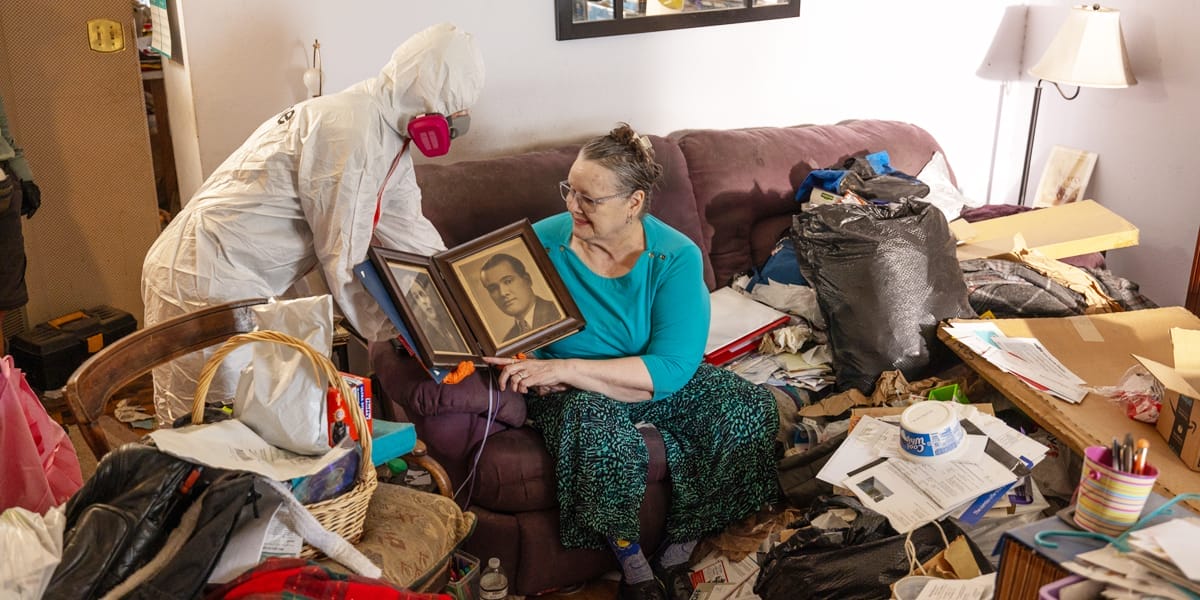
When someone you care about is struggling with hoarding, stepping in to help is the right thing to do. But without the right approach, even the best intentions can cause deep emotional pain and strain the relationship for years to come.
That’s because hoarding is rarely just about clutter. It’s about fear, trauma, grief, and loss. For the person who hoards, those piles aren’t just junk—they’re comfort, control, or connection. Having someone touch one's belongings without permission can feel like an invasion.
Here’s what we’ve seen time and time again:
That’s why Bio-One approaches every hoarding situation with more than just tools and trash bags—we bring compassion, patience, and a neutral, calming presence.
Here’s how we help preserve relationships and reduce emotional strain:
We’re not here to rush a process that takes time. We’re here to help everyone involved move forward together, with dignity, understanding, and as little conflict as possible.
Because cleaning a home is one thing, helping a family heal is something else entirely.
Hoarding isn’t just about piles of stuff. It’s about stories, struggles, and people who need help reclaiming their space—and sometimes, their life. That kind of transformation takes more than cleaning supplies and a crew with a truck. It takes compassion, patience, and a team that truly understands.
At Bio-One of Chicago, we’re not just here to remove clutter. We’re here to restore peace of mind, rebuild safety, and offer dignity to the people at the heart of it all.
If you’re facing a hoarding situation—whether it’s your own, a loved one’s, or a client’s—you don’t have to do it alone.
Call Bio-One of Chicago today. We’re ready to help—gently, respectfully, and without judgment. This isn’t just cleanup. It’s a clean start. And we’ll be with you every step of the way.
Bio-One specializes in hoarding cleanup, which goes far beyond surface cleaning or hauling away items. We assess safety risks, identify biohazards, and create a customized plan that considers emotional, physical, and environmental factors. We’re trained, certified, and compassionate—and we never judge.
Hoarded environments often contain hidden risks, such as mold, pests, structural damage, and biohazards (including feces, urine, and decomposing food). Attempting to clean up without proper equipment and training can lead to injury or illness. Our team utilizes protective gear and adheres to strict safety protocols to ensure the job is completed safely and thoroughly.
It depends on the size of the property and the extent of the hoarding. Some jobs can be completed in a single day, while others may take several days or longer. We’ll provide a clear timeline after our initial assessment and work at a pace that’s comfortable for you or your loved one.
Yes. We approach every situation with compassion and respect. We’re here to support—not shame—those struggling with hoarding. We listen, explain each step, and work at a pace that protects emotional well-being. Our neutral presence can also help reduce tension between family members.
We remove trash, damaged items, expired food, contaminated materials, and any other items that pose a health or safety risk. We always consult with the client about what should be kept, donated, or discarded. Valuables and sentimental items are handled with care and preserved whenever possible.
We’re trained to deal with mold, odor, and indoor air quality issues. During cleanup, we may use HEPA filters, deodorizers, and industrial-strength disinfectants to improve air quality and remove lingering odors. Mold is common in hoarded homes—and we know how to identify and safely treat it.
Yes. Rodents, roaches, flies, and other pests are common in hoarding situations. We remove nests, droppings, and contaminated items, and thoroughly clean and disinfect affected areas. If needed, we can recommend pest control partners to assist with pre- or post-cleanup services.
Absolutely. Animal hoarding creates very sensitive and hazardous conditions. Our team is experienced in handling these situations with discretion and care. We safely clean and disinfect areas affected by urine, feces, and decomposing material, while preserving as much of the home as possible.
In some cases, yes—especially if there is structural damage or biohazard contamination. We can help you navigate insurance claims and provide the necessary documentation to support the process. We’ll also clearly explain your options, including payment plans if needed.
Yes. We understand the stigma that can surround hoarding. That’s why we use unmarked vehicles (upon request) and work with complete discretion. We don’t share information, take photos without permission, or speak publicly about any job. Your privacy is always respected.
As a funeral professional, you're often the first call after tragedy. Families lean on you not just for arrangements, but for answers, compassion, and guidance through one of the most challenging moments of their lives.
But what happens when the loss also leaves behind a traumatic or hazardous scene?
That’s where Bio-One can help.
We specialize in after-death cleanup—cleaning homes, protecting families, and relieving one more burden during a heartbreaking time. Partnering with Bio-One allows you to extend your care, knowing your families are in expert hands.

As a funeral director, you work hard to provide comfort, clarity, and closure during life’s most painful moments. But when a family is also faced with cleaning a trauma scene, unattended death, or hazardous space, the emotional toll deepens—and so does the need for professional help.
We’re proud to be a trusted referral partner for funeral homes across the country. Our mission aligns with yours: to serve families with compassion, dignity, and discretion. When you refer Bio-One, you’re extending your care beyond the funeral and helping families take one more important step toward healing.
Here’s what you—and the families you serve—can expect:

After a sudden or unattended death, most families are already overwhelmed, grieving, making arrangements, and notifying loved ones. Many assume that once emergency responders leave or the funeral home steps in, everything is handled, including the cleanup.
Unfortunately, that’s not the case.
The responsibility of cleaning the scene often falls unexpectedly on the family’s shoulders. At a time when they’re emotionally raw, they’re faced with an impossible choice: enter the space themselves, hire an unqualified cleaner, or do nothing at all.
That’s where your voice—and your referral—can make a life-changing difference.
By simply recommending Bio-One, you help families:
Your recommendation may be the first time they’ve heard that this kind of help even exists. And in that moment, your reassurance means everything.
We’re not just another cleanup company—and we’re certainly not here to treat this as “just another job.”
At Bio-One of Chicago, our mission is rooted in something deeper: Help First, Business Second. That means leading with compassion, not just contracts. It means answering the phone at 2 a.m. because someone’s worst day can’t wait until morning. And it means showing up ready to help—not just with tools, but with heart.
We know the weight you carry as a funeral director. You’re more than a service provider—you’re a source of stability, strength, and reassurance for grieving families. When you recommend Bio-One, you’re extending that sacred trust to us. And we don’t take that lightly.
It’s why we prioritize:
This work isn’t just technical. It’s emotional. It’s human. We believe that the only way to do it right is with compassion, experience, and respect at every step.
Because when someone calls us, they’re not just hiring a cleanup crew. They’re reaching out for help. And we’ll always be there to answer.
Whether it’s an unattended passing, suicide, homicide, or infectious disease situation, Bio-One is ready to respond quickly, compassionately, and professionally. These are the kinds of situations no family is ever prepared for. But with the right team in place, they don’t have to face it alone.
By partnering with Bio-One, you’re offering families more than just a referral; you’re offering relief, protection, and peace of mind. You’re showing them that even after the service ends, they are still being cared for.
We believe funeral homes and cleanup professionals can—and should—work hand in hand. Together, we create a seamless experience that protects a family’s emotional well-being and honors the memory of their loved one.
Let’s talk about how we can support you and the families you serve:
We’re here. Anytime. No pressure, no obligations—just a conversation.
Reach out today and see why so many funeral directors choose Bio-One as their trusted partner.
We specialize in trauma and biohazard cleanup following unattended deaths, suicides, homicides, and infectious disease events. If a scene involves bodily fluids or potentially hazardous materials, we’re the right team to call.
Funeral professionals are trusted guides during emotional times. Referring Bio-One allows you to offer families one more layer of care—professional, compassionate cleanup services that reduce trauma and help them begin healing.
Yes. We’re available 24/7/365, including nights, weekends, and holidays. Loss doesn’t follow a schedule, and neither do we.
We typically respond within hours, and in many cases, even faster. Our goal is to arrive promptly so families don’t have to wait or face the situation alone.
Absolutely. We use unmarked vehicles and plain uniforms to protect the family’s privacy. Every technician is trained to act with empathy, discretion, and professionalism.
Our technicians are trained in OSHA regulations. We follow all federal, state, and local guidelines for biohazard cleanup and disposal.
We provide transparent, upfront pricing with no hidden fees. If insurance covers the cleanup, we’ll help the family navigate that process as part of our service.
Yes. We can supply referral cards, flyers, or even provide a short in-service overview of how we work. We’re here to make referring us as easy and seamless as possible.
Our mission is simple: Help First, Business Second. We combine professional training with genuine compassion, treating every family and every situation with the respect it deserves. We don’t cut corners, and we don’t rush through emotional situations.
Please feel free to contact us by phone or through our website. We’re happy to schedule a quick introduction, provide materials, or answer any questions you may have—no pressure, no obligations.
Fentanyl, an incredibly potent synthetic opioid, presents a hidden but lethal risk when it contaminates spaces. Originally developed to treat intense pain in medical settings, this opioid’s potency – up to 100 times that of morphine – requires careful, controlled handling.
However, fentanyl has made its way into the illicit drug market, where it’s often added to drugs like heroin, cocaine, and counterfeit pills, intensifying their effects and, in turn, the dangers. This covert presence of fentanyl has led to an alarming surge in accidental overdoses and fatalities among unsuspecting users.
But the threat of fentanyl contamination isn’t limited to drug users alone; it also extends to anyone who might come into contact with an affected area, including family members, landlords, first responders, and even cleanup crews.
Contaminated spaces range from drug labs and storage facilities to public areas, hotel rooms, and private residences – wherever traces of fentanyl can be left behind. The consequences of accidental exposure are severe, and even a minuscule amount can cause overdose or death. Given these critical health hazards, recognizing the risks of fentanyl exposure and understanding why cleanup requires specialized, professional intervention is crucial.
In cases where fentanyl contamination is suspected, attempting DIY cleanup is a risky – and potentially deadly – mistake. Only trained professionals with the right equipment and knowledge can ensure a space is safe again, effectively protecting individuals and communities from this invisible and often underestimated danger.
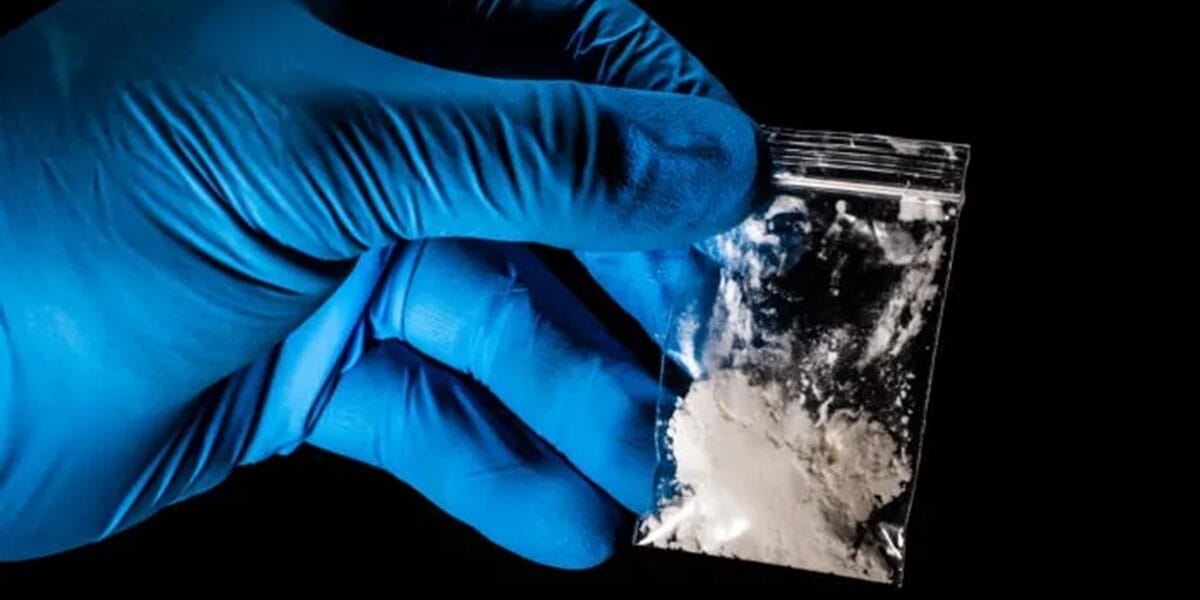
Fentanyl, a synthetic opioid used in medical settings, is 50 to 100 times more potent than morphine. While it is valuable for treating severe pain under controlled conditions, even a trace amount can lead to overdose and death.
Unfortunately, fentanyl has permeated the street drug market, leading to a tragic surge in accidental overdoses. This opioid is deadly not only for users but also for anyone who might come into contact with it unintentionally – from family members to first responders, cleanup teams, and even bystanders.
Here are critical points about fentanyl’s extreme dangers:
The combination of these factors makes fentanyl one of the most dangerous substances to encounter. Professional intervention is essential to ensure safety, as even slight exposure can result in severe health consequences, underscoring the need for thorough, expert cleanup in contaminated areas.
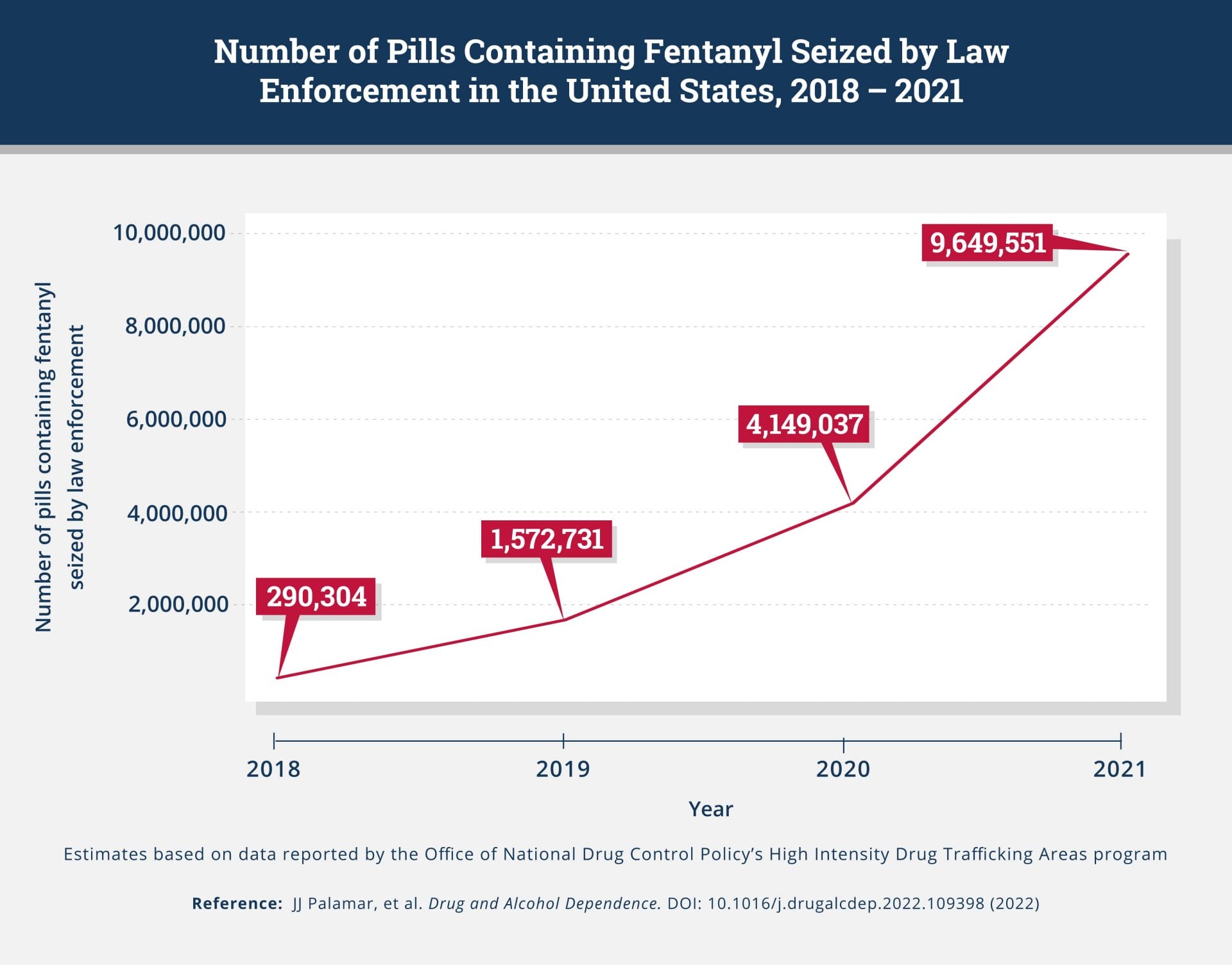
Attempting a DIY cleanup of fentanyl contamination is an extremely high-risk endeavor. Here’s why:
Bio-One’s certified technicians lead fentanyl cleanup with unmatched expertise and empathy, understanding the sensitive nature of such situations. Here’s why Bio-One is the premier choice for fentanyl decontamination:
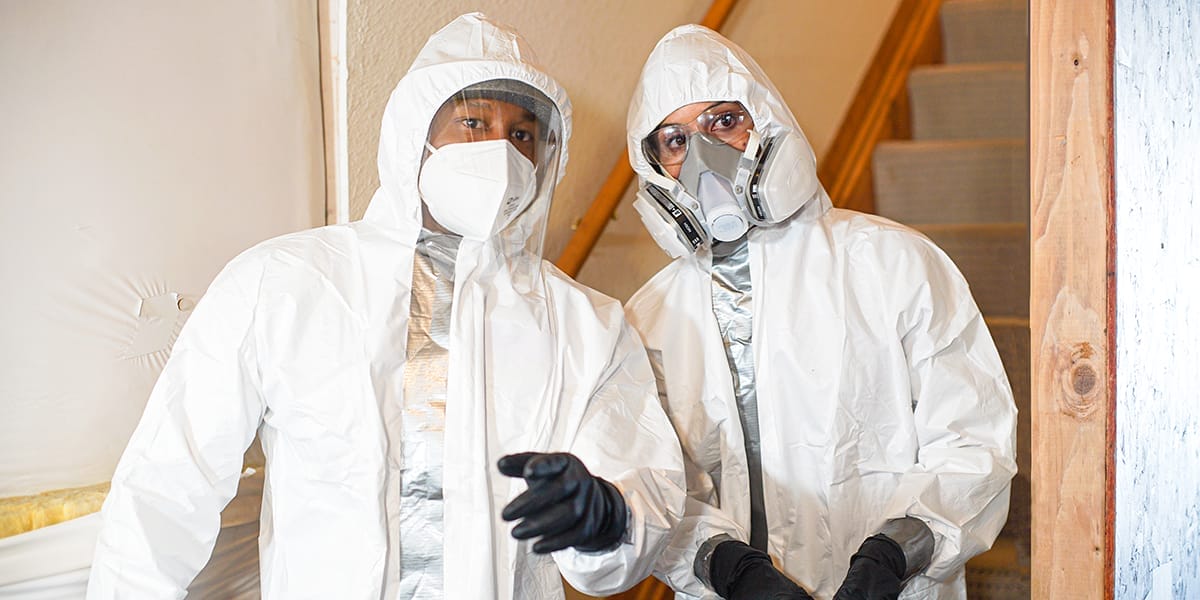
Choosing the wrong company for fentanyl cleanup can lead to catastrophic consequences. Here are the risks associated with unqualified cleanup services:
Bio-One of Chicago is dedicated to providing safe, thorough fentanyl cleanup services that safeguard families, public spaces, and public health. With a specialized approach and a compassionate commitment to each case, Bio-One stands out as a trusted partner for effectively reclaiming and restoring contamination-free spaces. Here’s what sets Bio-One’s fentanyl cleanup services apart:
Bio-One’s commitment to professionalism, safety, and compassion makes it an invaluable partner for anyone facing the dangers of fentanyl contamination. Their expert services provide the peace of mind that spaces have been thoroughly decontaminated and safely cleaned.
Fentanyl is 50 to 100 times more potent than morphine, making even a trace amount potentially lethal. Its ability to cause overdose from mere skin contact or inhalation adds to its high-risk profile.
Fentanyl can contaminate spaces through illicit drug manufacturing, storage, or usage. These locations can include private residences, hotel rooms, vehicles, and public spaces.
Anyone who comes into contact with a contaminated area is at risk, not just drug users. This includes family members, property managers, first responders, and cleanup crews.
DIY efforts lack the specialized equipment and knowledge needed to remove fentanyl safely. Without these, individuals risk severe health consequences from exposure.
Bio-One employs specialized cleaning agents and strict protocols to neutralize fentanyl's potency, ensuring all residues are safely removed from the contaminated areas.
Bio-One navigates the complex legal and insurance processes involved in fentanyl cleanup, ensuring compliance with regulations and aiding clients in managing claims.
If you suspect contamination, avoid the area and contact a professional cleanup service like
Bio-One immediately to handle the situation safely.
Yes, fentanyl residues might not be visible, making professional assessment critical to identify and safely clean all contaminated surfaces.
Cleanup times can vary, but Bio-One typically completes most projects within one to two days, depending on the extent of contamination.
Bio-One offers certified expertise, rapid response times, advanced cleaning techniques, and a compassionate approach, making them highly effective and sensitive to the needs of those impacted by fentanyl contamination.
Holding cells see a constant flow of detainees, many of whom arrive injured, intoxicated, or carrying infectious diseases. Blood, vomit, urine, drug residue, and even pest infestations can quickly turn these areas into biohazard hotspots.
While routine cleaning may address surface-level messes, it often fails to eliminate the hidden dangers that put officers, staff, and detainees at risk. Law enforcement professionals already face enough hazards on the job—exposure to biohazards in holding cells shouldn’t be one of them.
Ensuring these spaces are adequately decontaminated goes beyond sanitation; it’s a matter of health, safety, and compliance. That’s where Bio-One comes in. Our specialized biohazard remediation services help agencies maintain clean, safe detention areas while reducing risks to personnel and the public.

Officers and staff interacting with holding cells face exposure to various dangerous contaminants. Some of the most common biohazards found in these areas include:

While effective for general sanitation, standard cleaning protocols are not designed to eliminate biohazards. Many pathogens, drug residues, and contaminants require specialized equipment and training to remove correctly. Here’s why professional cleanup is essential:
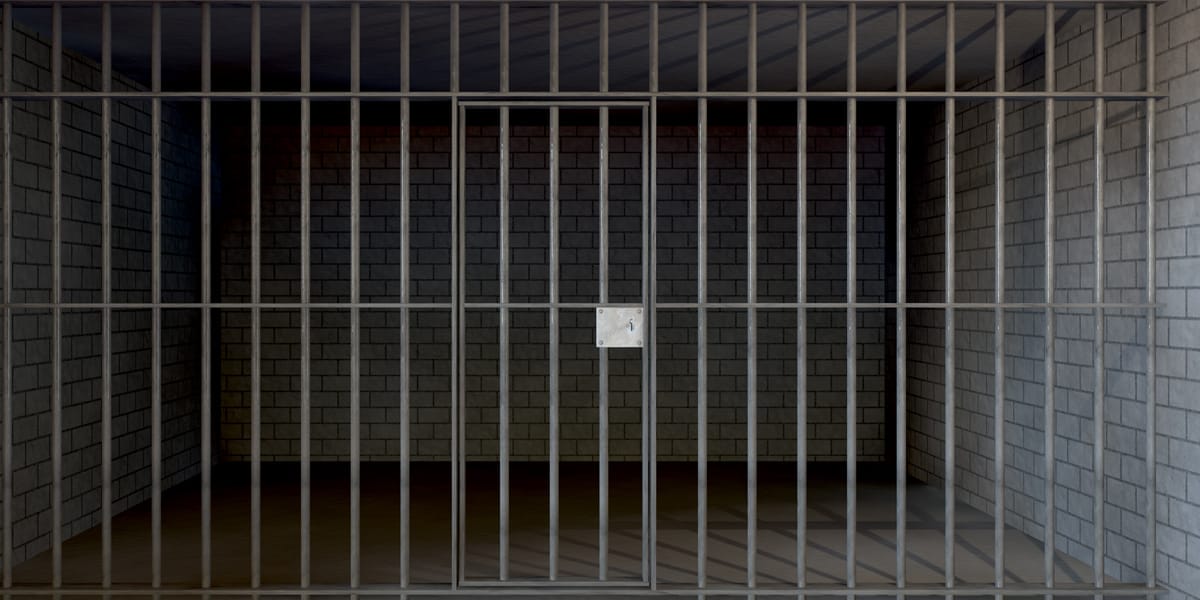
Bio-One specializes in biohazard remediation and works directly with law enforcement agencies to maintain clean, safe, and fully operational detention facilities. Our services include:
Law enforcement officers already face enough risks on the job—exposure to biohazards shouldn’t be one of them. By partnering with Bio-One for holding cell cleanup, agencies can ensure a safer environment for officers, staff, and detainees while maintaining compliance with health and safety standards.
For immediate assistance with biohazard cleanup in holding cells or other law enforcement areas, contact Bio-One of Chicago today at (708) 476-4763.
Holding cells frequently contain blood, vomit, urine, feces, saliva, drug residues (such as fentanyl or meth), and even pests like lice or bedbugs. These biohazards pose serious health risks if not properly decontaminated.
Standard cleaning methods may remove visible messes, but they often fail to eliminate pathogens, drug residues, and lingering contaminants that can cause infections, diseases, or secondary exposure to officers and detainees.
Bodily fluids can carry dangerous pathogens such as HIV, hepatitis B & C, tuberculosis, and MRSA. These contaminants can remain on surfaces without proper cleanup, increasing the risk of disease transmission.
Even trace amounts of fentanyl or methamphetamine can be hazardous. Officers and detainees can be exposed through skin contact or accidental inhalation. Professional decontamination ensures that all drug residues are safely removed.
Bio-One follows strict biohazard remediation protocols, using hospital-grade disinfectants, advanced decontamination techniques, and protective measures to eliminate biohazards, neutralize odors, and restore holding cells to a safe condition.
Bio-One provides 24/7 emergency response to law enforcement agencies, ensuring holding cells are decontaminated and ready for use as quickly as possible.
Yes. Bio-One adheres to OSHA, EPA, and local health department regulations, ensuring full compliance with safety and sanitation requirements for law enforcement facilities.
Proper decontamination prevents the spread of diseases, minimizes exposure risks for officers and detainees, and ensures compliance with safety regulations—reducing the likelihood of lawsuits related to unsanitary conditions.
Yes. Bio-One’s advanced cleaning techniques include odor neutralization, eliminating lingering smells caused by bodily fluids, vomit, or chemical contaminants like pepper spray.
Bio-One offers one-time emergency cleanups and scheduled biohazard cleaning services to help agencies maintain safe, sanitary holding cells. Law enforcement departments can contact Bio-One to discuss customized cleaning plans.
If you love someone who hoards, you’ve probably asked yourself, “Why can’t they just throw this stuff away?” It’s frustrating. It can feel like your loved one is choosing things over their own safety or happiness. But the truth is, hoarding isn’t just about being messy. It’s often related to a mental health disorder.
Behind the piles of stuff, there’s often a lot of pain. Your loved one might be struggling with anxiety, depression, trauma, or deep feelings of fear. The clutter you see is only part of the story. This Mental Health Awareness Month, let’s talk about what’s really going on—and how you can help.
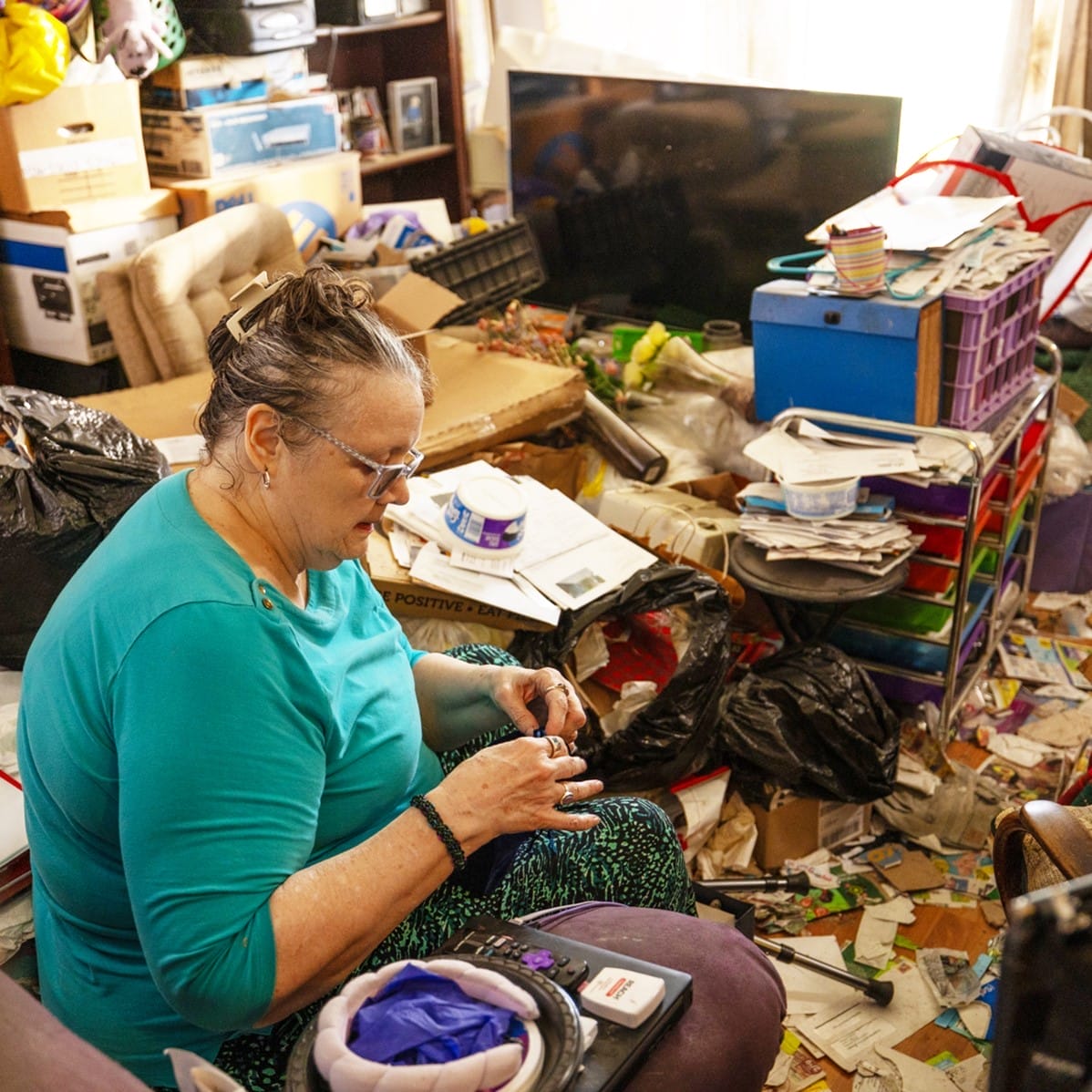
Hoarding disorder is when someone has a very hard time getting rid of things, even items that seem useless or broken. They feel a strong need to keep things, and just thinking about letting go can cause panic or sadness.
It’s not about laziness. It’s not about being dirty. It’s about how the brain is trying to protect itself. For many people, keeping things feels like a way to stay safe or in control, especially if they’ve been through something hard in life.
Signs of hoarding disorder might include:
When someone you love is living in a home filled with clutter, your first thought might be, “I’ve got to fix this.” You might want to step in, start tossing things, or give them an ultimatum. After all, you care about them and you’re scared for their safety.
But here’s the hard truth: Confronting someone with a hoarding disorder in a harsh or forceful way almost never works. In fact, it can make the problem worse. Hoarding is deeply emotional.
If a person feels judged, cornered, or forced to let go of their things, they may shut down entirely or hold on even tighter.
You’re not alone in feeling overwhelmed. But there’s a better way to help.
Here’s what works better:
When you lead with love instead of force, you build trust, which opens the door to real change.
Progress might come slowly, but every step made with patience and compassion is a step in the right direction.

Loving someone with a hoarding disorder isn’t easy. You may feel tired, angry, confused, or even hopeless. You might be trying to help while also juggling work, family, and your own emotions. It’s a lot to carry.
You care deeply, and that’s why you’re here, trying to learn more. But you also need care. Your feelings matter, too.
So many people are in the same situation—quietly worrying about a parent, sibling, spouse, or friend struggling. It can feel isolating, especially if others don’t understand. That’s why it’s important to reach out and get support for yourself, not just for your loved one.
Here are some ways to take care of yourself:
At Bio-One, we’ve seen how tough this road can be for families. That’s why we show up with compassion, not judgment, for your loved one, and for you.
You’re not failing. You’re not alone. You’re doing your best. And that’s enough.
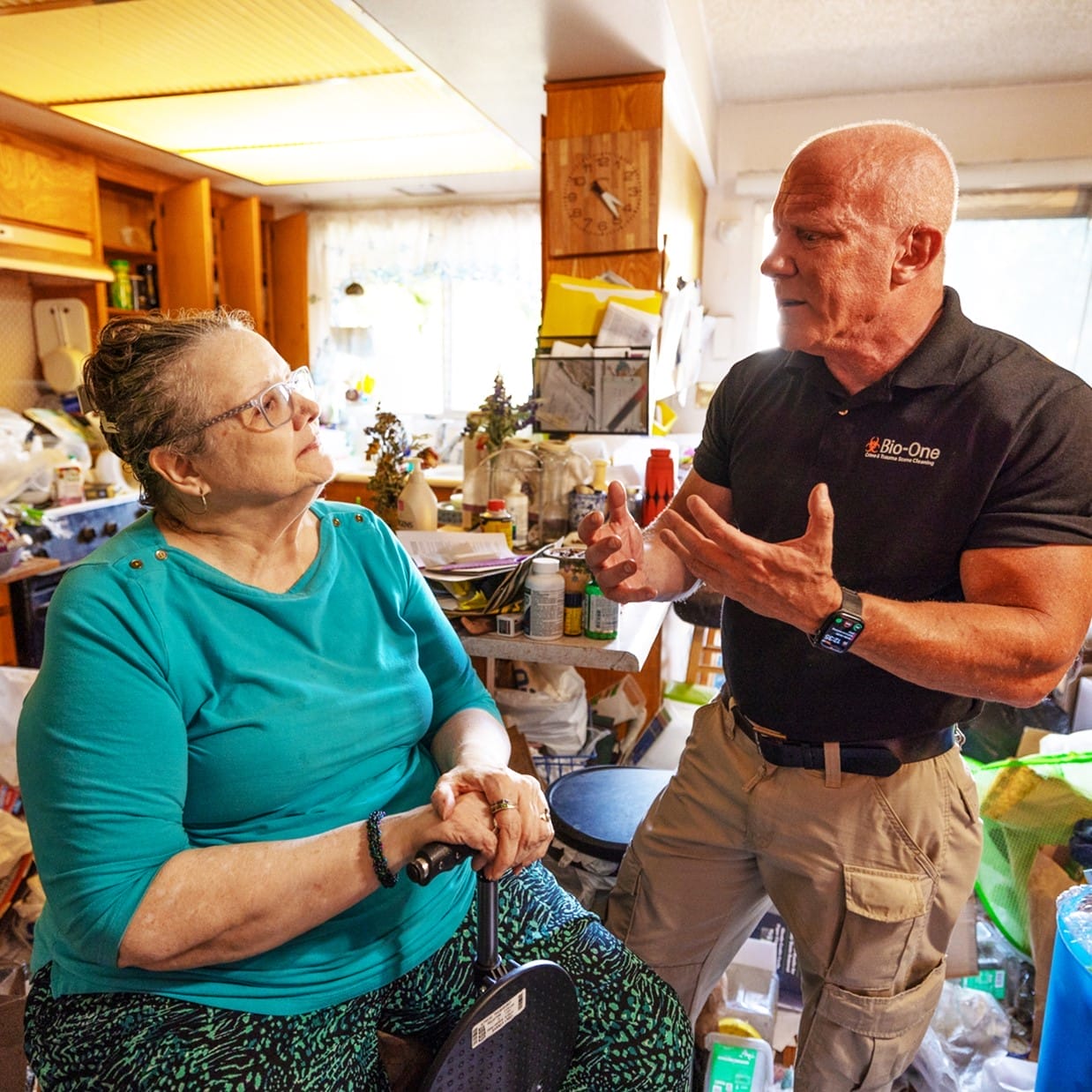
Sometimes, the situation is too big to handle by yourself. That’s where we come in.
At Bio-One of Chicago, we’ve helped thousands of families just like yours. Our trained technicians know how to clean cluttered homes with care and compassion. We don’t judge. We listen, we understand, and we’re here to help.
We work gently and respectfully to make the space safer and more comfortable. And we involve your loved one every step of the way, so they feel more in control and less afraid.
If someone you love has a hoarding disorder, it can feel overwhelming. But with time, support, and understanding, things can get better.
Progress doesn’t happen all at once. But each kind word, each small step, and each moment of support makes a big difference.
And when you need help, we’re here.
How to Help a Loved One With a Hoarding Disorder
Why Cleaning a Hoarding Mess is a Job for a Professional Hoarding Cleanup Service
Hoarding: Recognizing the Signs and Seeking Help. Finding hope and motivationto clean up your home.
Hoarding disorder is a mental health condition where a person has a very hard time getting rid of things. They often feel strong emotional attachments to items and may become overwhelmed or upset when asked to let them go.
No. Hoarding is not the same as being messy or disorganized. It’s a mental health struggle that usually involves deep emotions like fear, anxiety, or past trauma.
For someone with a hoarding disorder, letting go of items can feel scary or painful. What might look like trash to others might feel safe or important to them. Cleaning without their consent can cause stress or damage trust.
Start with kindness and concern. Use “I” statements like “I’m worried about your safety,” and avoid blaming. Focus on how you can support them instead of trying to take control.
This is common. Hoarding can bring up strong feelings. Try to stay calm and patient. Don’t push too hard. Give them time, space, and support. It may help to talk with a counselor or mental health professional for guidance.
No. Throwing items away without permission can break trust and make the situation worse. It’s important to involve your loved one in every step and help them feel safe and respected.
Helping someone with a hoarding disorder can be exhausting. Make time for yourself, set healthy boundaries, talk to a trusted friend, and consider joining a support group. You matter too.
Yes. Many people with hoarding disorder can improve with the right kind of help. Therapy, support from loved ones, and professional cleanup services that understand the emotional side of hoarding can all make a big difference.
If the clutter is unsafe, overwhelming, or beyond what you can manage, it’s time to call in trained professionals. At Bio-One, we approach each cleanup with care, compassion, and respect for your loved one.
Yes. We understand how emotional hoarding can be. Our goal is to make the space safer and more livable while treating everyone involved with dignity. We don’t judge. We’re here to help.